How to Create an Effective Dissertation Presentation
For many students, the task of writing a lengthy dissertation is so daunting that they forget about the need for Dissertation Presentation! Amidst all the hard work of researching and writing, students in some courses still need to prepare for a high-quality presentation that will help them earn top marks. This article will help you prepare and give you some essential tips for success.

The Purpose of Dissertation Presentation
There are two main types of Dissertation Presentation that are normally encountered in UK universities:
Mid-Research Presentations
Students will often be asked to present their dissertation work at a mid-point in their research. These presentations are usually made to a panel comprised of various faculty members from your department. In addition, they are sometimes structured as a postgraduate seminar, in which fellow students also attend. Both faculty and students can pose questions. The purpose of these Mid-Research Dissertation presentations is to provide students with an opportunity to demonstrate their progress and identify any weak areas that need to be addressed.
Assessment Presentations
Students are also sometimes required to make a Dissertation Presentation as part of their overall assessment . This is a much more formal presentation than the Mid-Research one, and it is usually open only to the student, examiners and the research supervisor. During an Assessment Dissertation Presentation, the student is required to present a summary of their research and results. They will then be asked questions by the examiners in a somewhat lengthy oral examination. The purpose of this Dissertation Presentation is to assess the student’s original research project and test its scholarly validity.
Differences in Undergraduate and Masters Presentations
Dissertation Presentations may be required at both Undergraduate (Bachelors) and Postgraduate (Masters) levels. The key difference between these levels is the length and degree of originality expected. Postgraduate Dissertation Presentations will normally be longer than Undergraduate Presentations, and they will demonstrate a greater degree of critical engagement with the subject matter. They will also demonstrate some degree of original thinking. By contrast, most Bachelors Dissertation Presentations will be shorter in length and will only require a thorough knowledge of the topic rather than an original scholarly contribution of any kind.
What to Include
- Broad subject area – What subject area of your discipline does your work fall into?
- Narrow topic area – Within this subject area, what is your specific topic? (This may be simply an expanded discussion of your research title).
- Relevant Existing Studies – What studies have already been done on your specific topic? What are their strengths and weaknesses? How does your work fit among them?
- Methodology and Philosophy – What methodology have you chosen to conduct your research? Is there a specific philosophical context? Why is this a good approach?
- Project Resources – If this is a Mid-Research Presentation, what resources do you require to complete the project? Furthermore, have you identified likely sources of funding, or do you need any difficult-to-acquire materials?
- Case Studies – If you’ve conducted practical fieldwork or lab research, why did you choose these cases or projects? How are they the best choices for researching your topic?
- Research Results – If this is a Dissertation Presentation for Assessment, note the results of your research in detail. Relate these back to your theoretical framework and discuss how the results support or contradict existing studies.
How to Prepare for your Dissertation Presentation
The best way to prepare for your Dissertation Presentation is to review your work carefully. Take notes of the key decisions you have made throughout your research and the scholarly literature that supports these choices. Make sure that you have a thorough understanding of the scholarly context of your research, which should have been achieved in your early research stages.
Once your content has been written, you should create a PowerPoint presentation to use during your talk. Don’t forget the slides should be informative but not wordy – keep bullet points concise and use pictures sparingly. Make sure that you rehearse your presentation several times.
What Sort of Questions to Prepare For Dissertation Presentation
The questions you will face in a Dissertation Presentation are designed to test your knowledge of the subject area and your awareness of the context of your work. You will be asked questions to determine how well you understand the potential criticisms of your project, and how well you are able to defend this. Therefore, remember to reference established scholars and existing research.
You might be asked about the specific choices you’re made with regard to methodology and case studies, and how you accounted for any possible inaccuracies in your resulting data. Similarly, examiners frequently ask students what they would do differently if they were starting the same project again.
You should also be prepared to answer questions about the ways your research might be applied within your field, and how it might be supplemented in future. This is an effective way for examiners to assess the originality of your research, and consider its potential impact on your subject area.
How to Earn a High Mark
Much of your dissertation mark will come from the written work and the research project it represents. However, a good Dissertation Presentation will help make a strong case for a good overall mark, whereas a weak Presentation will confirm any doubts in the examiners’ minds. As such, here are a few key areas for success:
- Good Presentation Skills. As with any Presentation, it is important to speak clearly and concisely. Stand still and look your audience in the eye, and try not to rely too much on notes. Be sure to keep breathing and don’t rush your words!
- Knowledge of the Topic. If you truly have a good understanding of your topic you will be likely to do very well. Remember, much of the Dissertation Presentation is designed simply to test your knowledge. If you’ve kept pace with your reading assignments and practical work you should have no problem answering any questions that are posed to you.
- Professional Behaviour. Stay calm and focused during your Presentation, and answer any questions with objectivity and professionalism. Don’t be drawn into debates, but instead offer references to other scholars whose work supports your own agenda.
- Take Your Time . Many students make the mistake of rushing through their material and answering questions too quickly. This doesn’t give the audience a chance to thoroughly understand the quality of your work. Furthermore, it risks leaving out essential information and neglecting to demonstrate the depth of your research.
You may also like
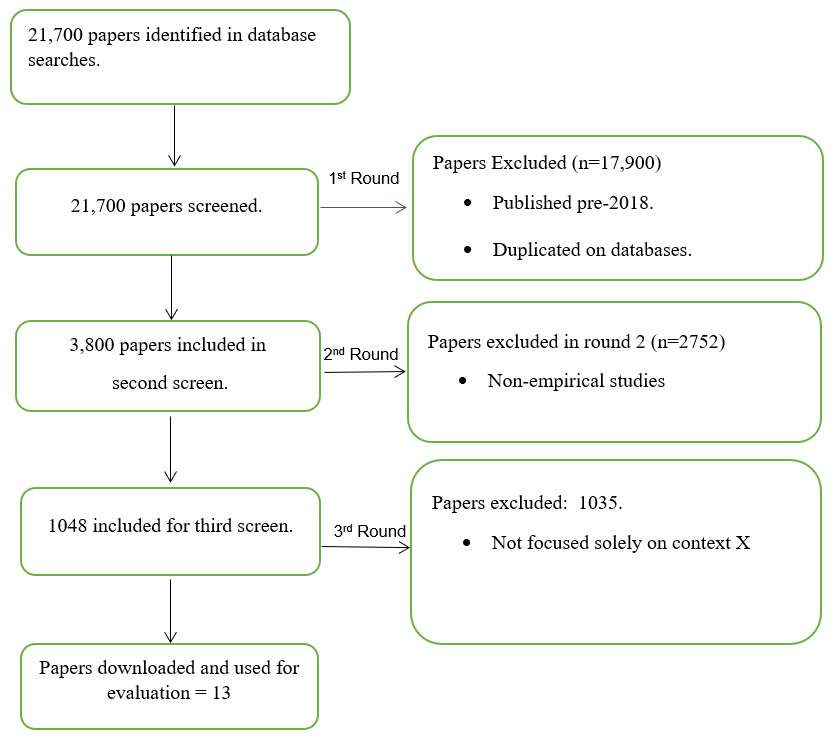
How to Pull Off Your Thesis Defense With a Great Presentation

You’ve reached the home stretch in your journey toward your post-graduate degree. You’ve diligently studied, researched and performed for years, and all that’s left is your master thesis or doctorate dissertation.
“ All that’s left,” however, might be the understatement of the century. There’s nothing simple about orally defending your thesis, and this final stage often means the difference between a degree and a program that remains incomplete.
Even after you’ve dedicated months filled with blood, sweat and tears defining your argument, researching your support and writing your defense, you aren’t ready to address the academic panel. You still have to design an effective visual presentation, and the slide deck can make or break your entire thesis.
Unsure how to design a stellar slide deck to visually present your thesis or dissertation? Check out the following tips to pull off your master thesis defense with a great presentation:
1. Properly structure your slide deck
Every master thesis defense presentation is unique, but most effective slide decks will follow a similar structure, including:
- Title - Just like a research paper, your thesis presentation must include a title slide. This should include the same information as any other title page: the title, your name, your academic institution, course name and the name of the academic advisor to your thesis or dissertation. That doesn’t mean your title slide needs to look like the start of any other Frankendeck . Instead, add your text atop a relative image, and adjust the brightness to ensure your text pops.
- Introduction - Your thesis presentation should also include an introduction slide, which details the topic of your thesis, the question your research will seek to answer and any additional objectives to your research, as well as the answer or solution you will be defending.
- Literature review - Following your thesis introduction, design one or more slides that review the literature you researched. This shouldn’t be a full bibliography (although that should be included in the accompanying written account of your research), but instead, the slides should list your most relevant research sources. If the information is featured on a slide, make sure you include its source.
- Methodology - Your thesis presentation slide deck should also include a slide (or slides) detailing the methodology of your research and argument. Here you want to describe the type of study— whether it’s quantitative, qualitative or a combination of the two, as well as an explanation of why you chose the method or methods you used. If you conducted original research, you will want to detail the study population, sampling methods and other details pertinent to your studies, while you’ll also want to detail how you analyzed your data.
- Results - No thesis presentation slide deck is complete without dedicating slides to illustrate the results of your research. Be sure to include a description of any data you collected through your research, as well as the results of your analysis of the data. What were your most significant findings?
- Discussion - How do the results of your research support your overall thesis argument? Be sure to include slides that discuss your overall findings and how they relate to your original question.
- Conclusion - Concluding slides should restate your original research questions, represent the results of your research, suggest future research and make any final recommendations.
- Ending slide – Close your thesis presentation with a concluding slide that offers an interesting quote or trivia that makes your audience further ponder your topic, a GIF or animation that recaptures the audience’s attention or even a hypothetical question that opens additional discussion from the academic panel. This is your opportunity to make your presentation memorable.

Thesis Presentation vs. Dissertation
Thesis presentation and dissertation are two terms often used in academic settings related to upper education. While they are related, there are distinct differences between the two, which is important to understand as you begin to structure your thesis defense.
A thesis presentation typically refers to the final oral presentation that a student gives to defend their thesis or research project. It is a formal presentation to explain their findings, methodology, and conclusions to a panel of faculty members or experts in the field. The purpose of a thesis defense presentation is to demonstrate the student's knowledge and understanding of the subject matter and to defend the validity of their research.
On the other hand, a dissertation refers to a lengthy and comprehensive research project that is typically required for the completion of a doctoral degree. It involves in-depth research, analysis, and the development of original ideas in a particular field of study. A dissertation is usually written over an extended period and is expected to contribute new knowledge or insights to the field. Unlike a thesis presentation, a dissertation is submitted in written form and is typically evaluated by a committee of faculty members or experts in the field.
2. Choose which ideas to illustrate
Unless you have an hour to fill with your master thesis defense or doctorate dissertation, you won’t be able to include every idea from your overall research documentation in your slide show. Choose the most important ideas to illustrate on slides, while also keeping in mind what aspects of your research you’ll be able to visually represent.
.jpeg)
3. Define your presentation’s theme
A stellar thesis or dissertation presentation will be professional in appearance, and a cohesive design is an absolute must. Choose what types of typography and color schemes best support your topic.
Instead of adjusting these settings on each individual slide— a tedious task at best— choose a PowerPoint-alternative presentation software like Beautiful.ai that allows you to customize a theme for your entire slide deck. Choose your fonts and other typography, your color palette, margins, footers, logos, transitions and more, and the cloud-based tool will automatically apply those design specifications to every slide you add to the master thesis defense presentation.
4. Design simple and focused slides
You might have a lot of information to present, but when it comes to your thesis presentation— or almost any slide deck for that matter— less is more. Be sure every slide counts by focusing on your main points.
Then, whatever you do, keep your slides simple. Not even an academic panel is going to dedicate much time deciphering a cluttered slide with all too many details. Try to avoid presenting more than one or two ideas on each slide.
5. Include data visualizations
The whole point of your presentation is to illustrate the concepts included in your thesis. Humans are visual creatures and react strongly to imagery, and the panel evaluating your thesis or dissertation is no exception— regardless of how studious and formal the academics might seem. Illustrate the results of your research with colorful and engaging infographics . You don’t have to be a graphic designer to create them, either.
Beautiful.ai users can choose from a host of smart slide templates with data visualizations — including favorites like bar graphs and pie charts , as well as less common options like scattergraphs , flow charts and pictograms . Just input your data and watch as our special brand of artificial intelligence creates the infographic for you.
6. Practice makes perfect
After spending months researching your thesis or dissertation, writing about your findings and designing a stellar master thesis defense presentation, you would hate to see all your hard work be for naught. That’s still a distinct possibility, however, if you don’t also practice your delivery.
Practice, practice and practice some more until you know your master thesis defense like the back of your hand. No academic panel will be impressed by a graduate candidate who stumbles through their presentation or appears to be reading from their notes. Know the contents of every slide, as well as exactly what parts of your overall defense you want to deliver during its display.
Things to keep in mind to help you nail your presentation
The golden rule of any presentation is to keep your audience engaged. You can ensure a more engaging presentation by maintaining eye contact, using appropriate gestures, and speaking clearly. You can also choose to include the audience in your presentation with interactive questions, polls, and slides.
To help boost audience retention, utilize storytelling. Studies show that when facts are presented in the form of a story, people are 22 times more likely to remember them. Talk about powerful.
Last but not least, plan for questions— and not simply by allowing time for them. Watch other thesis defenses delivered at your institution, and consider what types of questions the academic panel might ask, so you can prepare the best possible answer.
Extra credit:
Get started with our PhD Defense Thesis presentation template here .

Samantha Pratt Lile
Samantha is an independent journalist, editor, blogger and content manager. Examples of her published work can be found at sites including the Huffington Post, Thrive Global, and Buzzfeed.
Recommended Articles
How to use video to engage your audience, medical presentations: how to present effectively on urgent topics, 6 creative presentation tools to make your presentation more engaging, what are the basic rules for creating a presentation.
- Slidesgo School
- Presentation Tips
How to Start a Thesis Defense Presentation

After months and years of hard work, the moment to wrap things all up is finally here—your thesis defense presentation.
Whether you’re pursuing a master’s degree or doctorate, it’s the final step to that much-deserved achievement.
A thesis defense requires a lot of prior research and preparation. And as important as its content is, so is how you present it because a stunning design with clear data and text hierarchy plays an immense role in comprehension.
In this article, we’ll explore how you make your thesis defense .
The organization is the key to success. Establishing some previous steps before any project or work is essential for the result to be very positive. And the defense of a thesis could not be less.
Below, we will develop all the necessary steps to make a thesis defense presentation and we will give you some tips on how to carry them out.
How to Make an Amazing Presentation
Defining the concept of your thesis presentation, structuring your thesis defense presentation, how do you welcome the audience, tell them why you did this thesis, go into the content by explaining your thesis part by part, how to end the defense of the thesis.
After a long time of research and study, the content of your thesis is ready. Now, you have to find the best way to reflect all that effort behind your work. The information comes across more clearly if you use a visual format, as it attracts the attention of the audience. To present your thesis information in a clear, concise, and ultimately amazing way, you can use one of our unique thesis defense templates , available at Slidesgo.
As an example, in this article, we are going to use the Ecology Thesis template . With it, we will show you what to include in your presentation and how to make an attractive design.
After choosing the Google Slides and PowerPoint template that best suits the needs and subject matter of your thesis, it is time to define an overarching concept.
This is the main theme on which your designs are based. It must be relevant to your thesis as its purpose is to guide your selection of colors, typography, images, style, etc.
These must be portrayed in a way that supports the main message of your slides and should be aligned with your concept both visually and sociologically.
Once you have defined the concept, you will have to move on to the next step: structuring the content of your thesis. A good structure will show that there is a good organization behind the work, but most importantly: it will highlight your content.
In this article, we are going to show you a structure that could be a good example of how to structure a thesis, but you can adapt it to what your specific content requires.
Before you begin your thesis defense, you should welcome your audience. A good presentation will make you connect with your audience, which will result in more general interest in your work.
Use an appropriate language register (avoid informal language), but be approachable and natural.
"Welcome to the thesis defense on [the title of your thesis]". Next, introduce yourself with your name and give a short description of your background and occupation.
Don't forget to say “thank you for attending!”
To continue establishing that connection with your audience, explain the reasons that led you to do this thesis. Tell the professional reasons, and you can even say some personal ones, which will denote closeness, and your audience will appreciate it.
Now it's time to go into the content of the thesis ! After these preliminary steps, which are just as important as the thesis itself, it is time to explain part by part the structure (which you had previously established). We are going to propose a structure for your project, but the final decision is always yours!

First impressions are very important. Because your title page is the very first thing viewers see, it must be striking and impactful. It also sets the stage for the rest of your slides.
In one glance, the following should be established:
- Thesis defense topic
- Design style
For instance, the ecology thesis’s title page uses illustrations of a natural landscape to represent the topic of nature and a striking shade of blue to set the tone.
The sans serif font used depicts clean-cut typography and style and the thesis topic is written in large and bold typography, which draws attention to it immediately.
.jpg)
Right after your title page, include an introduction slide to provide more details about your topic.
This means explaining what you hope to answer with your research, its importance to your field, and why you chose it.
Continue to incorporate design elements relevant to your concept. This example has done just that by using a different natural landscape and including animals. For coherence, stick to the same typography and style throughout your presentation.
.jpg)
The aim of the literature review slide is to illustrate your knowledge of your thesis topic and any relevant theories.
Walls of text kill a design. For clarity, we recommend presenting this with bullet points. Each one should be short and sweet and only touch on the basics; you can elaborate on them in your speech.
Don’t forget to be consistent with your design. In our example, we’ve maintained the tone of blue chosen and added illustrations of leaves in the far corners of the slide.
Also, address similar research that has been done. This is to showcase your topic’s originality and, if relevant, how it’s different and/or an improvement from previously done research.
.jpg)
This is one of the most important parts of a thesis defense presentation.
It allows your viewers to assess the rationality and validity of your approach and consequently, the accuracy of your results.
A great methodology slide explains the what , how, and why :
- What method did you use for your research
- Why did you choose it
- How did you conduct it
Because this part of your thesis will be rather technical, the most effective way to aid understanding is by using graphics like charts and tables.
.jpg)
Keep text to a minimum to avoid drawing attention away from the graphics. If there is a text that must absolutely be included, consider using bullet points and keep them short.
Don’t forget to maintain color, style, and typography coherence.
.jpg)
The results slides are easily the most quantitative part of a thesis defense.
Here, your aim is to simply introduce your findings. Select the most impactful data and highlight them here.
Just as with methodology, use graphics like charts, tables, and graphs to portray the data in a clear way. And, once again, try not to write too much text. Let the visual content do the talking .
.jpg)
After you’ve introduced your data, the next step would be to help your audience make sense of it. That means understanding what it means in the context of your thesis research topic and your discipline.
Simply put, you should answer the question: What do the numbers mean?
The best way to approach this would be to do it as if you were creating an infographic .
Illustrations like icons are a quick and simple way to represent your message. It also reduces the amount of text on your slide, which makes the information much more digestible.
For a balanced thesis presentation, you should also address any outliers and anomalies.
To quote bestselling author Robin Sharma, “Starting strong is good. Finishing strong is epic.”
That’s exactly what to aim for in your conclusion.
Provide an overview of your thesis topic and remind your audience what you set out to answer with your research. In our example, we’ve used three icons accompanied by a short title and text.
.jpg)
Following that, reiterate the important points of your research results you want your audience to take away from your thesis defense presentation.
You can do so by expanding the next slide to have more icons and points, for example.
.jpg)
Don’t forget to address any shortcomings and limitations in your approach and extra points for suggesting possible improvements for future research.
We are going to give you a little tip to make your thesis defense a success. You can combine your defense with good public speaking techniques. Take a look at our article "How to become a great speaker" .
We hope this article has been of great help, have you already seen our templates to make the presentation of your thesis ? Choose the one that best suits your needs, we are sure that one of them will go perfectly with your thesis presentation!
Good luck from Slidesgo.

Do you find this article useful?
Related tutorials.

Work faster, teach better: boost your skills with Slidesgo Academy
We truly believe that every educator has what it takes to be a fantastic presenter, but we’re also aware of the time it takes to hone these skills. Enter Slidesgo with a great, fast solution: Slidesgo Academy.At this empowering and encouraging platform, we’ve partnered with veteran classroom educators to compile the best tips that will enable you to create engaging, eye-catching, and top-quality presentations for your students and fellow educators. You’ll surprise yourself with how quickly you can craft lessons that engage and excite. Join us as a student, and become the best teacher you can be!

7 tips to create a positive classroom culture
No matter if it's been ages since you last stepped into a classroom or just a long time ago―there’s probably a particular learning experience you often find yourself thinking about. Maybe it was a passionate teacher who kept the whole class engaged, or perhaps a classmate who lent you a hand with a tricky topic. Positive classroom experiences do leave a lasting mark on us, so it makes perfect sense that people leading a classroom aim to create the finest possible learning setting. In this article, we’ll share some tips to help you turn a regular classroom into a positive space.

How to create a word cloud in Google Slides
There are many ways to improve your Google Slides presentation. From choosing the right font to finding the right template, good presentations keep an audience engaged and convey a message in a clear way.Knowing how to visualize data in a slideshow is one of those actions that have a huge impact on the success of a presentation. At the end of the day, plain data fails to motivate decisions as effectively as clear insights do. This is when powerful visual tools like word clouds step in. Let us tell you all about them.

How to create a word cloud in PowerPoint
In the age of information, showing data has become as important as collecting it. Those who are able to turn big amounts of data into easy-to-understand ideas, are the ones pushing the game forward.At the end of the day, plain data fails to motivate decisions as much as clear insights do. That’s where powerful visual tools such as word clouds step in. We’re here to tell you all about them.

- Code of Ethics
- Dissertation Editing
- Dissertation Coaching
- Free Consultation
How to Create a Dissertation Presentation
While writing your dissertation is a Herculean task, the work isn’t quite over once the dissertation is finished. In many disciplines, a dissertation presentation is required as part of the dissertation defense . This thorough, comprehensive presentation is your opportunity to demonstrate the depth and validity of your research in a clear and compelling way.
Before you begin working on your dissertation presentation, you’ll want to do some homework about the expectations for your presentation. Consult your dissertation advisor and ask for your department or university’s guidelines for the dissertation presentation. It may also be helpful to review dissertation presentations made by recent graduates of your doctoral program.
These are some commonly asked questions about the dissertation presentation:
- What is a dissertation presentation?
- How does it differ from a dissertation defense?
- How do I structure my dissertation presentation?
- What are some additional considerations for the dissertation presentation?
What Is a Dissertation Presentation?

A dissertation presentation is usually a 10-15 minute overview of your dissertation research that focuses on the study and findings recorded in chapters four and five of your dissertation. The dissertation presentation consists of 9-12 slides made using PowerPoint or another type of presentation software.
There are conventions to adhere to when creating the dissertation presentation, and each slide serves a specific purpose. The presentation slides offer in-depth insight into the data gathered during the study, as well as any conclusions you may have reached. These slides give you an opportunity to explore the data and discuss the significance of your study and its findings.
Dissertation Presentation vs. Dissertation Defense
While the culminating moment of a doctoral degree has long been the dissertation defense, many disciplines and programs now prefer for candidates to complete a dissertation presentation. Done in lieu of or in addition to a traditional defense, a dissertation presentation is made distinctive by its inclusion of visual elements such as charts, graphs, or images.
Dissertation presentations are also a pragmatic approach during the era of online programs and Zoom. While a dissertation defense is powered by an oral defense and discussion with the dissertation committee, a dissertation presentation offers a strategic way to plan and structure the conversation. A dissertation presentation also affords you the opportunity to show the narrative arc of your progression from asking the question, searching the literature, creating the study, and evaluating your findings.

Dissertation Presentation Structure
Storytelling is a great way to think about how you will approach your dissertation presentation. Show the linear development of your topic and offer a clear and concise snapshot of the work you’ve done. Bear in mind that brevity is important; slide space is limited, so you’ll want to keep it short and sweet.
The structure of your dissertation presentation will roughly follow your table of contents, which will serve as a map for crafting your slides. The first half of your dissertation presentation slides will mirror your dissertation proposal, or the first three chapters of your dissertation. Slides within your dissertation presentation should include:
- Problem Statement Write a sentence or two outlining the problem and why it caught your attention.
- Literature Review Offer observations about the general consensus of existing research on or related to your topic, as well as gaps in the literature–particularly those bridged by your research study.
- Purpose of the Study This statement should reflect the purpose statement in your dissertation .
- Research Questions Include your primary question as well as secondary questions that resulted from gaps in the literature.
- Sample and Population/Instrumentation This would be a good place to include graphics or other visual elements.

The second half of the slides in your dissertation presentation will be grounded specifically in the fourth and fifth chapters of your dissertation. These slides will include information about your data collection, analysis, and findings. You can also include an image or two relevant to your research (especially if you have pictures from the field or lab) and personal experience.
- Data Collection and Analysis Include charts or graphs that illustrate your research on this slide.
- Research Findings It may be difficult to abridge dozens of pages of results, but try to summarize your findings in a sentence or two. A table may be the best way to present your results.
- Implications Now we’re getting to the good stuff! You’ve offered a thorough overview of the research you did; take the opportunity to highlight why it matters. What dark corner of your discipline is now illuminated because of the work you’ve done?
- Recommendations As a now-bona fide scholar in the field, this is a place for you to offer recommendations for further research. Identify two or three more research questions that you encountered during the course of your research. What is the next chapter of this story?
- Abstract Compose a 100-150 word abstract for your dissertation . Follow the format of a journal article. This will come in handy for submissions to conferences and journals (the next step on your academic journey!).
- Acknowledgements A quick ‘thank you’ never hurts–feel free to copy your acknowledgements from your dissertation. Don’t forget to thank your committee.
- Questions Use the final slide of your dissertation presentation to open the floor for questions from your dissertation committee.

Additional Considerations
Though it is first and foremost a professional document, the dissertation presentation also offers you an opportunity to showcase your style as a scholar. Design your slides for optimum communication and visual appeal. Use graphics and images that reinforce the overarching message of your dissertation. These visual cues will serve as compelling support for your overall narrative, and each one should enhance your dissertation committee’s understanding of your topic, findings, and analysis.
In addition to graphics and images, think carefully about the aesthetic of your dissertation presentation. Prize high-impact verbiage that gets to the heart of your topic without crowding your slides. Give yourself enough time to draft and revise each slide; it’s not a bad idea to get a second set of eyes on your dissertation presentation, as well as constructive feedback. Remember, this is your final chance to make a lasting impression on your dissertation committee –give them a presentation they won’t soon forget.
Related posts:

Courtney Watson, Ph.D.
Courtney Watson, Ph.D. is an Associate Professor of English at Radford University Carilion, in Roanoke, Virginia. Her areas of expertise include undergraduate and graduate curriculum development for writing courses in the health sciences and American literature with a focus on literary travel, tourism, and heritage economies. Her writing and academic scholarship has been widely published in places that include Studies in American Culture , Dialogue , and The Virginia Quarterly Review . Her research on the integration of humanities into STEM education will be published by Routledge in an upcoming collection. Dr. Watson has also been nominated by the State Council for Higher Education of Virginia’s Outstanding Faculty Rising Star Award, and she is a past winner of the National Society of Arts & Letters Regional Short Story Prize, as well as institutional awards for scholarly research and excellence in teaching. Throughout her career in higher education, Dr. Watson has served in faculty governance and administration as a frequent committee chair and program chair. As a higher education consultant, she has served as a subject matter expert, an evaluator, and a contributor to white papers exploring program development, enrollment research, and educational mergers and acquisitions.
Comments are closed.
How to Finish Your Dissertation in Half the Time
Learn how to avoid the pitfalls preventing you from finishing your dissertation faster.

Subscribe to get the free eBook!
Dr. Courtney Watson In the News
“ See It for Yourself ” in With Good Reason: Beyond the Book July 22, 2022
“ I Thought You’d Never Ask: Consent in Contemporary Romance ” in New Frontiers in Popular Romance (McFarland) June 13, 2022
- Common Errors
- Dissertation Success
- Presentation
- Quantitative Analysis
- Surviving Grad School
“How to Finish Your Dissertation in Half the Time”

Princeton Correspondents on Undergraduate Research
How to Make a Successful Research Presentation
Turning a research paper into a visual presentation is difficult; there are pitfalls, and navigating the path to a brief, informative presentation takes time and practice. As a TA for GEO/WRI 201: Methods in Data Analysis & Scientific Writing this past fall, I saw how this process works from an instructor’s standpoint. I’ve presented my own research before, but helping others present theirs taught me a bit more about the process. Here are some tips I learned that may help you with your next research presentation:
More is more
In general, your presentation will always benefit from more practice, more feedback, and more revision. By practicing in front of friends, you can get comfortable with presenting your work while receiving feedback. It is hard to know how to revise your presentation if you never practice. If you are presenting to a general audience, getting feedback from someone outside of your discipline is crucial. Terms and ideas that seem intuitive to you may be completely foreign to someone else, and your well-crafted presentation could fall flat.
Less is more
Limit the scope of your presentation, the number of slides, and the text on each slide. In my experience, text works well for organizing slides, orienting the audience to key terms, and annotating important figures–not for explaining complex ideas. Having fewer slides is usually better as well. In general, about one slide per minute of presentation is an appropriate budget. Too many slides is usually a sign that your topic is too broad.

Limit the scope of your presentation
Don’t present your paper. Presentations are usually around 10 min long. You will not have time to explain all of the research you did in a semester (or a year!) in such a short span of time. Instead, focus on the highlight(s). Identify a single compelling research question which your work addressed, and craft a succinct but complete narrative around it.
You will not have time to explain all of the research you did. Instead, focus on the highlights. Identify a single compelling research question which your work addressed, and craft a succinct but complete narrative around it.
Craft a compelling research narrative
After identifying the focused research question, walk your audience through your research as if it were a story. Presentations with strong narrative arcs are clear, captivating, and compelling.
- Introduction (exposition — rising action)
Orient the audience and draw them in by demonstrating the relevance and importance of your research story with strong global motive. Provide them with the necessary vocabulary and background knowledge to understand the plot of your story. Introduce the key studies (characters) relevant in your story and build tension and conflict with scholarly and data motive. By the end of your introduction, your audience should clearly understand your research question and be dying to know how you resolve the tension built through motive.

- Methods (rising action)
The methods section should transition smoothly and logically from the introduction. Beware of presenting your methods in a boring, arc-killing, ‘this is what I did.’ Focus on the details that set your story apart from the stories other people have already told. Keep the audience interested by clearly motivating your decisions based on your original research question or the tension built in your introduction.
- Results (climax)
Less is usually more here. Only present results which are clearly related to the focused research question you are presenting. Make sure you explain the results clearly so that your audience understands what your research found. This is the peak of tension in your narrative arc, so don’t undercut it by quickly clicking through to your discussion.
- Discussion (falling action)
By now your audience should be dying for a satisfying resolution. Here is where you contextualize your results and begin resolving the tension between past research. Be thorough. If you have too many conflicts left unresolved, or you don’t have enough time to present all of the resolutions, you probably need to further narrow the scope of your presentation.
- Conclusion (denouement)
Return back to your initial research question and motive, resolving any final conflicts and tying up loose ends. Leave the audience with a clear resolution of your focus research question, and use unresolved tension to set up potential sequels (i.e. further research).
Use your medium to enhance the narrative
Visual presentations should be dominated by clear, intentional graphics. Subtle animation in key moments (usually during the results or discussion) can add drama to the narrative arc and make conflict resolutions more satisfying. You are narrating a story written in images, videos, cartoons, and graphs. While your paper is mostly text, with graphics to highlight crucial points, your slides should be the opposite. Adapting to the new medium may require you to create or acquire far more graphics than you included in your paper, but it is necessary to create an engaging presentation.
The most important thing you can do for your presentation is to practice and revise. Bother your friends, your roommates, TAs–anybody who will sit down and listen to your work. Beyond that, think about presentations you have found compelling and try to incorporate some of those elements into your own. Remember you want your work to be comprehensible; you aren’t creating experts in 10 minutes. Above all, try to stay passionate about what you did and why. You put the time in, so show your audience that it’s worth it.
For more insight into research presentations, check out these past PCUR posts written by Emma and Ellie .
— Alec Getraer, Natural Sciences Correspondent
Share this:
- Share on Tumblr


Researched by Consultants from Top-Tier Management Companies

Powerpoint Templates
Icon Bundle
Kpi Dashboard
Professional
Business Plans
Swot Analysis
Gantt Chart
Business Proposal
Marketing Plan
Project Management
Business Case
Business Model
Cyber Security
Business PPT
Digital Marketing
Digital Transformation
Human Resources
Product Management
Artificial Intelligence
Company Profile
Acknowledgement PPT
PPT Presentation
Reports Brochures
One Page Pitch
Interview PPT
All Categories
The Ultimate Guide to Delivering an Outstanding Master's or PhD Thesis Dissertation Defense Presentation (Over 20 Templates Included)

“Congratulations, Dr. (Your Name)”
These words can be music to the ears of a research scholar at the end of their master’s dissertation defense presentation. All those years of hard work ( and the occasional partying ) on an A-list university campus boil down to you earning the title of a doctorate. Your blood, sweat and tears ( mostly tears ) invested in the doctoral subject of your choice just to hear the committee assign you that title rest on one (not so) simple thing: your dissertation defense.
However, to ensure that you, indeed, achieve your goal of earning that title, you have to ace your dissertation defense. You want to impress the committee. You want to ignite their minds. And more so, you want to be prepared for all the hard-hitting questions they are going to pose when you click through your dissertation defense presentation slides and explain what all you grasped in your years of research at the university.
Nerve-wracking may be an understatement, wouldn’t it?
Accomplishing that PhD with a well-presented dissertation defense can be an uphill battle for those who get the jitters while facing an audience. Plus, anticipation of top-level questions from experts in your field can leave you hot under the collar. You want to ace that dissertation defense, no matter what.
Fear not! This blog will break it down for you. Read on to find out how to make your master's or PhD thesis dissertation defense an outstanding medium to charm the thesis committee with ease.
The preparation
Now, before the dissertation defense, you have to prepare for it well in advance. Just organize your thoughts and prepare your thesis in a well-structured manner before you hand it over to the thesis committee. When you have studied a particular topic at length, you are able to devise a strategy for presenting it to the experts as well. Doctoral research gives you extensive knowledge about a topic which you can see yourself working with in your future prospects. Mostly university programs are inclined to the analyzing how the research has been fruitful with your endeavors. Here, you must note some important points to prepare well.
Know thy audience
When you have your dissertation defense to prepare, it bodes well for you if you try to get to know your audience, i.e. the members of the thesis committee. Before you make the final submission to the committee chair, make a checklist of what all you have included in the dissertation report. In fact, submit the report at least a month in advance so that the chair is ready to capture what your point of contention will be. You do not have to just brush things off with the normal two-week-prior submission. You have to give yourself a chance to prepare for what the committee members can ask you as per their expertise.
While you can ask your adviser or guide to take in the subject, it will also work well if you meet the chair in person for advice on the general thought process of the committee members. So instead of going into the meeting room unarmed, you will have a bit of a groundwork laid for yourself. It is all in the mind, but it is also all in a bit of a control.
Watch, ask and learn
Your research adviser or guide is your biggest asset when it comes to earning that doctoral degree. Since a dissertation is based on what you have explored and found out during the university course based on an original research, you can get the best advice from your guide. Ask them what kind of presentation methodology you need to adhere to. You can also take reference from the university’s scholar resources.
More so, since the dissertation defense presentations are open in most of the universities, you can attend these to get an idea of the procedure involved. Watch closely how the committee dwells on the key aspect of a scholar’s research. Also, see how the scholar handles the questions, the tough ones. Is that a straight “No I don’t know.” or something refined like “I speculate that…”? Ask the previous scholars who have presented their dissertation in front of the committee members you have. The more similar the subject, the better your chances of nailing that presentation.
Accustom yourself
Yes. Everybody has thrown this one at you before an exam (or a date). Practice makes perfect. When we talk of laying the groundwork, it involves booking the meeting room and the committee members’ schedule for your final dissertation defense well in advance to avoid any lapses. University research experts and thesis committee members have busy schedules around which you need to plan your dissertation defense. Planning in advance can keep you from having the last-minute anxieties.
- A secret to giving an outstanding dissertation defense presentation is to present in front of your colleagues or friends. It will be a bonus if this practice audience is a mix of scholars from your field and different fields as well. The idea is to influence the minds of the listeners as analogous to those of the committee members. Use notes and feedback from this audience to plan out what you will say on the day of the presentation.
- Another secret to being well-prepared is to keep the chosen committee members in loop with your research process after you have submitted a dissertation proposal. You can ask them for reviews and incorporate the changes they suggest. These changes can then give you an indication on what could be the basis of the questions the committee will ask. Since the experts are aligned to pose such questions as interest their mind for exploration, you can keep a track of the reviews you have subjected your dissertation to. If the committee members suggest some major changes and you make them, keeping them in the loop will help avoid any last-minute surprises, and therefore, blunders.
- Since university doctoral research has to be published online and even distributed as written text, it is important to take some guidance from your adviser and teachers about formatting standards. It makes it easy if you get it formatted well enough before submitting the manuscript to the committee members for final notes and revision suggestions. Each institute may have their own standards for devising a dissertation manuscript. So know the process to avoid careless mistakes. Your research matters not only to you, but to the university as well.
- Ask your adviser how much time is allotted to each part of your dissertation defense presentation. This way you can plan as much material as you should for your presentation. Time slots will keep you structured throughout your presentation. You can focus on the key issues and give time to each topic as per the structure as follows.
Make your presentation right
Your dissertation defense presentation is your masterpiece. It can sway the committee members in your favor. Designing a good dissertation ppt presentation that implores the audience to say that much-wanted YES is an art. Once you get the basics right, you will start off with a bang. The basic setup which you should employ while putting together your presentation is as follows:
The very first slide of the presentation is going to be your title slide. It should include the name of your thesis and your name. Mention the university’s name in a prominent manner as well. A catchy title slide can keep your audience visually stimulated before the presentation.

#2 Introduction
You have a well-defined slot within which you introduce the subject of your doctoral research. You have to cover broad points by focusing on the pain point first. You can take an example of how that pain point is leading to an issue that needs attention. The introduction has to enlist what objectives your research has tried to achieve to address these pain points. Here the key point is to show that you have tried to solve a problem with your research. You can give the scope of the research too. Starting off with an anecdote may also help get the committee members interested in your topic up front. Make sure you include these points in your introduction slide.

#3 Literature review
Often one of the common mistakes that scholars do while dissertation defense is getting too much into the literature review. If you have studied and included the findings of a particular research to support your thesis, you do not have to dwell on it. Simply create a crisp outline of the research literature that relates to your thesis. You can include how the literature is relevant or brings out any weak points that you may have addressed in your research.
#4 Methodology
You have covered the what of your thesis. On this slide, you will cover the how of it. On this slide, you need to explain what you did to address the pain points listed in the introduction. Did you conduct a survey of a considerable sample size to apply your research to? What were the subjects of the survey categorized into? How did you organize and process the data? This slide (or slides) can show the committee members the tools at your disposal and how you used them to support your claims.
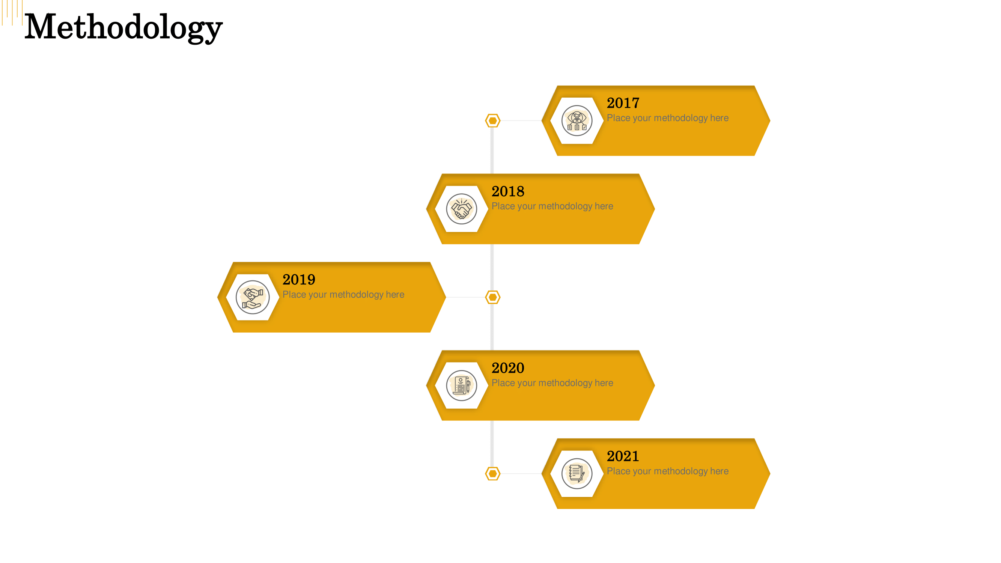
#5 Findings
You used the collected data in every decipherable manner you could. But what you found through processing and extrapolating that data as per your thesis goes on this slide. You can use simple infographics to draw comparison or to highlight the specific results that you want the committee members to take note of. The trick here is to make the information as captivating yet concise as possible. Make sure you put the spotlight on the findings that address the pain points or at least enhance the committee’s discretion regarding your thesis.
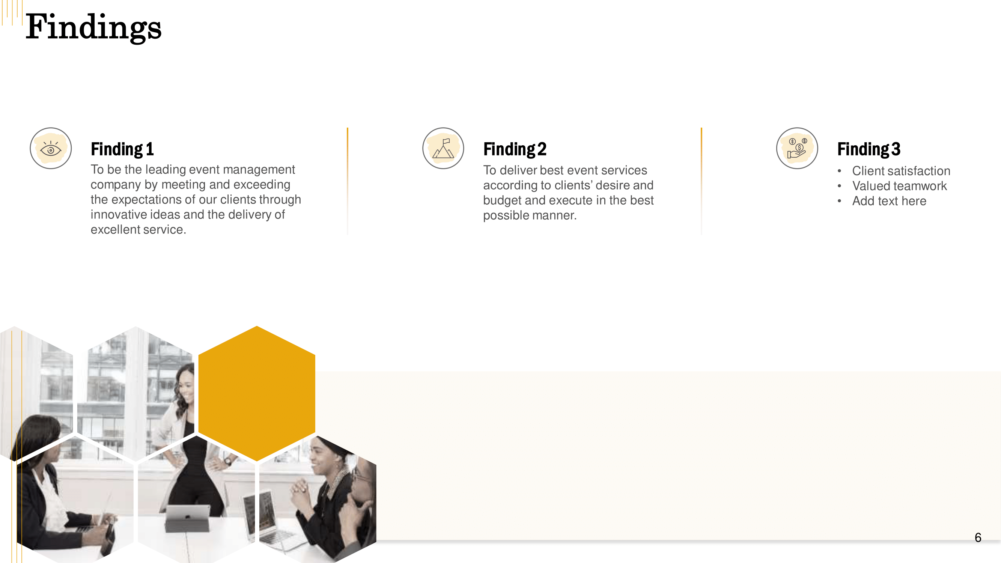
#6 Deliberation
On this slide for discussion, you have to enlighten the committee on how the findings have a bearing on your research. What it means for the issues that you listed as worthy of being addressed? You can elaborate how using your findings you have come up with some innovative solution to a problem.

#7 Conclusion
You have started well. So end well too. On the conclusion slide, just keep it short and sweet on how your research addresses the scope of the subject. You can also impress the committee with giving how your processed data can serve as the foundation stone of many more research projects in your field (if there is any).

- Know your subject inside out. Take time to review what your thesis proposal tries to encompass. Enlist all the possible questions that you have found out to be of the committee’s interest.
- Also, enlist the questions that you fear the committee may ask. These are trick questions for which you should have an answer ready.
- You have to organize your thesis precisely. Take your time arranging your thoughts well.
- Take a closer look at the already published manuscripts to have an idea of what content to dabble with while preparing for your dissertation defense.
- Prepare handouts in accordance with your presentation. You can take printouts of the presentation slides and put them together so that the committee can follow along.
- A quick proofread of all the material you prepare or print won’t hurt either.
- Do not fret or be nervous about the presentation.
- Do not clutter the presentation slides with content. Just keep it crisp enough so that the committee stays engaged with you while taking cues from the slides or handouts.
- Do not forget to analyze the accuracy of the data sets and the projections. Your findings are your foundation. Accuracy and precision are key.
The dissertation defense
Had a good night sleep the day before the defense presentation? Good! Because a relaxed mind is paramount for an effective dissertation defense. The meeting is nothing short of a mental roller coaster. Before the presentation, hand out the printed slides to the committee so that they can follow along. During the dissertation defense, the committee will ask you questions on topics that pique their interest. So be ready to not lose focus no matter what.
Generally, the questions will mostly come at the discussion phase of the presentation so you must have a cohesive idea of how your research connects the dots. Mostly these questions will be based on why your dissertation matters, and how does it support future researches. The committee will also deliberate on the relevance of your findings to your career trajectory, besides any scope of future contributions. Here it is crucial that you have such information on your fingertips (although don’t fret if you do not know the answer at the ready).
- Know your material inside out.
- Check the meeting room arrangements an hour before the defense.
- Greet the committee members. Make eye contact with each of them.
- The committee is not there to torture you. They just want to examine the significance of your project for the university.
- Give handouts to the panel before starting the presentation so that any incoherence can be avoided.
- Pause before explaining each meticulous point of interest. Often the pressure gets the best of the most skilled orators too.
- Always, and always, take notes when the committee asks questions.
- Do not overburden your mind with data. Just know enough of important figures and you are good to go.
- Avoid getting distracted by the presentation. Just keep small notes to help the committee stay up to speed.
- Do not fall into the trap of “umm and uhhhh” during questioning. It is okay if you do not know the answer. Do not turn it into a fumbled description. You can try saying something encouraging like “I have not explored that asset to that extent, but would like to add that…” This shows your drive to learn and communicate well.
- Do not panic if there is a glitch in your presentation or a power outage. Conduct the dissertation defense with confidence. That is what handouts are for.
- Steer clear of speaking hurriedly to answer a question. Time slots can be a concern but the more you stay focused and calm, the easier you are able to handle the occasional bumps in the road.
For remote presentation
Incidentally, Covid-19 has changed the way academic presentations are conducted, though remote presentations were a thing in the past. In instances where you have to present your dissertation defense from a remote location, you must ensure proper testing of the video output that the committee members can see. Ask a friend to check it. Better yet, practice with an audience. Internet lapses can throw you off your track. So make sure you have checked each and every provision for the meeting. Last-minute obscurity of the slides may not be a good head start.
Now, for some people, employing the cyberspace to present their dissertation defense may not be ideal. Also, dissertation committee members may take part from different countries, so you have to be prepared. Make sure you email them the handouts or rather short notes so that it is easy for them to understand. Keep in touch with them digitally as and when feasible. The more you prepare in advance, the better.
After the presentation
If you have followed the steps given above, chances are that the committee has had a consensus on awarding you that YES based on your dissertation defense presentation. You have indeed earned that by being an expert in your field. But what to do after the presentation?
First and foremost, you have to officially thank all the committee members for their time and guidance. Take notes on whatever the members advise you regarding your research. Rather solicit feedback after you are done with the dissertation defense. You can also ask them to email their suggestions to you. It will help pave the way to your future courses of action. Be on the same page with your committee chairperson for what to do next. If the committee has deliberated on suggesting some revisions, you can incorporate them in your final manuscript.
Also since your research has been scrutinized well according to the university standards, you must get on with making copies of your manuscript once approved and signed by the committee members. Later on you can submit it to the university database in the library. You can also submit the final revised manuscript to your colleagues.
And then what? It is time to celebrate, of course. Circumstances and university guidelines permitting, you can have a nice celebratory function with the committee members and your family and friends to mark an important milestone in your career.
Ace that dissertation defense with these PPT templates
Since so much rests on your presentation before the committee, it is imperative that you make a mark with a well-designed presentation. You want to make a good impression with your dissertation defense. So, do it with bespoke professionally-designed dissertation defense PowerPoint presentation templates listed here. Read the highlights and choose the template that will speak for you.
As discussed above, your dissertation defense has to be your instrument of research during your master’s or PhD course. And good professional design in this template is the element you can harness. Plus the biggest beneficial factor is that you get to edit the slides in it as per your wish. In fact, when you prepare your key notes, you can just put them on the slides and present it with ease.

Download this template
We understand that every university may have a different requirement when it comes to presenting a well-researched thesis dissertation defense. So we have curated simple template designs that fulfill your needs. Take advantage of this completely editable deck to organize your thoughts and dissertation material to impress the thesis community from the get go. No matter what topic you have chosen to secure a master’s degree in, you will never go wrong with this template. Present with conviction. Present with confidence.

Meticulous is the mantra when presenting your dissertation defense with passion. It is your subject of expertise. So you must make a good impression when preparing your presentation. Take notes regarding the key points you have gotten in guidance from your adviser. Use this template with attractive infographic slides to put forward your points with credence.

When you need that zeal to support your dissertation defense, you have to present with well-represented facts and figures. This template offers fully editable design that you can mould as per your convenience. If you have fallen short of time, use this template to get bespoke design that amalgamates seamlessly with your dissertation defense content. This comes handy especially when you want the committee’s focus to be on your findings. That way, they will get straight to the point and ask questions that your research an answer.

Sure you have got some time on your hands to prepare a dissertation defense. But why spend hours and hours on figuring out the design and theme of your presentation? Do it quick with this uniform and comprehensive dissertation defense presentation template that will represent your thoughts in a much organized manner. The best part about this template is that it will come in handy in situations of time crunch when preparing for the defense has consumed much of your schedule. Smart work can make the dream work too.

Another template that will be a blessing for your readiness is this one. Herein you get a simple design that will structure your dissertation defense as per the university standards of professionalism. Usually, simplifying concepts for your audience takes a lot of studying and research, which may not leave you much time to prepare a cohesive presentation. The solution lies in this template. Just place your text onto the slides wherever applicable and remove the stuff you do not need. Present and win.

Some universities give preference to a more vibrant dissertation defense presentation. While the design requirement stays professional, a simple white theme with a smart color pattern can also magnetize the committee’s focus to your presentation. The more the retention of focus, the better are the chances of the committee understanding your subject and giving better feedback. You can leverage this recipe to success with the following template. Just edit in minutes and present with caliber.

If you want to project your ideas of research with an offbeat theme, try this template. The colors are easy on the eye and you can easily ace your dissertation defense. Plus the data charts for your findings can be used with easy to understand description. You must check with your university guidelines on drafting a presentation though. If it sticks by the rules, you have your perfect presentation at the ready.

Speaking of themes that appeal to the eye, this template has what it takes to get you that YES. No beating around the bush. Just cutting straight to the point, the template follows a procedural approach with design. Point after point, you can capture the essence of your PhD thesis in a structured manner. You can also rearrange the elements on the lucid slide to fit your requirements. Once you edit the slides, you can take printouts to give to your thesis committee for easy understanding.

Template 10
Explaining the pain points that your research is addressing takes a lot of well-structured analysis. Thereafter, aligning these points to a PowerPoint presentation that you have to make from scratch is not an easy task. Time is of the essence. And so is this thesis presentation ppt template. Edit the required text in 5 minutes with this efficient and user-friendly design. Believe in yourself and present an exquisite dissertation defense.

Template 11
The more you fidget about your presentation, the less confidence you will have. So you must concentrate on getting yourself better prepared instead of rummaging through old-school templates. Time management gets simplified when you use this template. With catchy design and highlights, this template will fit well with the professional dimensions of your dissertation defense. Get it now and get started with a bang.

Template 12
Talk of starting with a bang! To a layman, a dissertation defense may seem like an extremely scientific discussion full of jargon. But in reality it is a tool for a researcher to break down the most complex concepts and put a spotlight on their utility and admissibility through the lens of experts in the field. To tell your story the right way, use this professionally-designed template. This will be useful in those situations where you have a larger audience than just the committee.

Template 13
You know what can help you hit the bull’s eye? A good infographic. And this template has it, and much more. In fact, the infographics and icons follow a common theme to give your dissertation defense that professional edge. Just make sure you remove the dummy text wherever needed and input the text you have summarized in the abstract of your thesis. You can also use the data charts in the slides that follow to convince the committee members regarding your finding.

Template 14
Often students of master’s program ignore the importance of presenting a crisp methodology for their research in front of the thesis committee. With this template, you can use a timeline infographic to trace the projection of your research. Explain the methodology with crisp information for your audience. The template also has the bibliography slide to mention the sources of your data and project collateral. You can download the completely editable presentation and use it to sway the committee in your favor without a doubt.

Template 15
A key precaution that you ought to take while designing the perfect dissertation defense presentation is not to clutter the slides with too much text. Just keep everything crisp. In fact, to get the committee members more engaged with your slides and the corresponding handouts, use this template with minimal text. Just resize the font so that it is legible on the projection board. Clearer text with simple imagery can drive home the point that you came prepared with convincing figures.

Template 16
Icons sure are better than boring bullet points. They also add to the readability of your presentation. With this template, you can leverage an exceptional form of visual communication. You can keep as many icons as you like as per the cohesive theme that the template is designed on. Moreover, quicker presentation preparation will give you time to focus on organizing your thoughts for the dissertation defense. You can also tabulate your findings in the consecutive slides to give the committee more clarity.

Template 17
Definitive research warrants a well-structured dissertation defense. Elaborate your thoughts and ideas with this template. With this template you can offer in-depth analysis about your thesis while keeping the presentation well within the time frame as stipulated by the university guidelines. Make sure you are using the data charts and infographics the right way to represent the corresponding information. You can practice the presentation with ease through this template.

Template 18
It is all in what appeals to the eye; and in your case, the committee’s eyes. Each committee member can pose tricky questions about your study. Why is it relevant? What could be an alternative approach? Explain all that with simple points on this template that has visually appealing theme that grabs attention in an instant. You can make do without the extra slides at the back if you want to keep the presentation short. Just make sure you highlight each point of interest on every suitable slide.

Template 19
Since your thesis can catapult your prospects to successful heights, you might need a presentation that can make an impact even after you have gotten the approval of the committee and got your research published. For example, with the help of this template, you will have something that you can use for a business research proposal as well. Your dissertation proposal will be your USP for potential recruiters as well. So having this precisely designed and well-structured template will help you get the opportunity and projects you want.

Template 20
When it comes to a business setup, researchers are expected to come up with new ideas and proposals. Research is needed for sales expansion, marketing strategy and business growth. So when you get into that professional ecosystem, you must leverage your learning in the master’s program to devise well-structured research proposals as well. This template will help you put together every element of your research and project your vision for the company in an appealing manner. Present and convince the stakeholders within minutes.

Template 21
The best part about fully customizable slides in our collection is that we make it a point to elevate your presentation quotient with our designs. As far as a dissertation defense is concerned, you can easily achieve flexibility during the Q&A with the committee by keeping it short and sweet with this template. Mostly the committee is interested in how you handle the questions related to future implications of your research. You can include the points you are absolutely confident about in this template, so that the committee’s attention stays focused on these ideas. Edit this template as per your liking and let it speak for yourself.

Template 22
Every year, scholars after scholars submit their thesis and perform to their highest capacities in dissertation defense to get that coveted doctorate. Since universities expect them to adhere to the most significant levels of professionalism and structure, it is important for them to be outstanding. And outstanding comes from an outstanding template like this. It is the perfect blend of icons, visual appeal and flow. Use this template to present the most complex concepts in a simple manner.

So in conclusion, your dissertation defense has to go just perfectly for you to accomplish your academic and professional goals. And perfect comes from a perfect presentation. Follow this guide and choose from any of the listed templates to express your thoughts. If you need a little boost to that seat of success, let our design team handle the ride . Cheers to your bright future!
Related posts:
- [Updated 2023] Top 20 Hiring and Recruitment Templates in PowerPoint PPT
- Top 20 Sustainability, Social Responsibility and Climate Change Presentation Templates for Business and Environment Presentations!!
- [Updated 2023] Top 20 Organizational Behavior Presentation Templates for PowerPoint!!
- Increase The Cohesiveness Of Workplace With Our Top 20 Organizational Culture Presentation Templates for PowerPoint!!
Liked this blog? Please recommend us

3 Design Hacks to Make Images Bleed in Your Presentation

Crawl Your Text! Add News Ticker Effect to Your Presentation Using This Hack

PowerPoint vs. Other Presentation Software: Which Is Better for Creating, Presenting, and Sending Sales Pitches?

A History of Portrait and Landscape Formats: How They Started and Why We Are Still Stuck With Them
This form is protected by reCAPTCHA - the Google Privacy Policy and Terms of Service apply.

Digital revolution powerpoint presentation slides

Sales funnel results presentation layouts
3d men joinning circular jigsaw puzzles ppt graphics icons

Business Strategic Planning Template For Organizations Powerpoint Presentation Slides

Future plan powerpoint template slide

Project Management Team Powerpoint Presentation Slides

Brand marketing powerpoint presentation slides

Launching a new service powerpoint presentation with slides go to market

Agenda powerpoint slide show

Four key metrics donut chart with percentage

Engineering and technology ppt inspiration example introduction continuous process improvement

Meet our team representing in circular format


- Publication Recognition
How to Make a PowerPoint Presentation of Your Research Paper
- 4 minute read
- 122.6K views
Table of Contents
A research paper presentation is often used at conferences and in other settings where you have an opportunity to share your research, and get feedback from your colleagues. Although it may seem as simple as summarizing your research and sharing your knowledge, successful research paper PowerPoint presentation examples show us that there’s a little bit more than that involved.
In this article, we’ll highlight how to make a PowerPoint presentation from a research paper, and what to include (as well as what NOT to include). We’ll also touch on how to present a research paper at a conference.
Purpose of a Research Paper Presentation
The purpose of presenting your paper at a conference or forum is different from the purpose of conducting your research and writing up your paper. In this setting, you want to highlight your work instead of including every detail of your research. Likewise, a presentation is an excellent opportunity to get direct feedback from your colleagues in the field. But, perhaps the main reason for presenting your research is to spark interest in your work, and entice the audience to read your research paper.
So, yes, your presentation should summarize your work, but it needs to do so in a way that encourages your audience to seek out your work, and share their interest in your work with others. It’s not enough just to present your research dryly, to get information out there. More important is to encourage engagement with you, your research, and your work.
Tips for Creating Your Research Paper Presentation
In addition to basic PowerPoint presentation recommendations, which we’ll cover later in this article, think about the following when you’re putting together your research paper presentation:
- Know your audience : First and foremost, who are you presenting to? Students? Experts in your field? Potential funders? Non-experts? The truth is that your audience will probably have a bit of a mix of all of the above. So, make sure you keep that in mind as you prepare your presentation.
Know more about: Discover the Target Audience .
- Your audience is human : In other words, they may be tired, they might be wondering why they’re there, and they will, at some point, be tuning out. So, take steps to help them stay interested in your presentation. You can do that by utilizing effective visuals, summarize your conclusions early, and keep your research easy to understand.
- Running outline : It’s not IF your audience will drift off, or get lost…it’s WHEN. Keep a running outline, either within the presentation or via a handout. Use visual and verbal clues to highlight where you are in the presentation.
- Where does your research fit in? You should know of work related to your research, but you don’t have to cite every example. In addition, keep references in your presentation to the end, or in the handout. Your audience is there to hear about your work.
- Plan B : Anticipate possible questions for your presentation, and prepare slides that answer those specific questions in more detail, but have them at the END of your presentation. You can then jump to them, IF needed.
What Makes a PowerPoint Presentation Effective?
You’ve probably attended a presentation where the presenter reads off of their PowerPoint outline, word for word. Or where the presentation is busy, disorganized, or includes too much information. Here are some simple tips for creating an effective PowerPoint Presentation.
- Less is more: You want to give enough information to make your audience want to read your paper. So include details, but not too many, and avoid too many formulas and technical jargon.
- Clean and professional : Avoid excessive colors, distracting backgrounds, font changes, animations, and too many words. Instead of whole paragraphs, bullet points with just a few words to summarize and highlight are best.
- Know your real-estate : Each slide has a limited amount of space. Use it wisely. Typically one, no more than two points per slide. Balance each slide visually. Utilize illustrations when needed; not extraneously.
- Keep things visual : Remember, a PowerPoint presentation is a powerful tool to present things visually. Use visual graphs over tables and scientific illustrations over long text. Keep your visuals clean and professional, just like any text you include in your presentation.
Know more about our Scientific Illustrations Services .
Another key to an effective presentation is to practice, practice, and then practice some more. When you’re done with your PowerPoint, go through it with friends and colleagues to see if you need to add (or delete excessive) information. Double and triple check for typos and errors. Know the presentation inside and out, so when you’re in front of your audience, you’ll feel confident and comfortable.

How to Present a Research Paper
If your PowerPoint presentation is solid, and you’ve practiced your presentation, that’s half the battle. Follow the basic advice to keep your audience engaged and interested by making eye contact, encouraging questions, and presenting your information with enthusiasm.
We encourage you to read our articles on how to present a scientific journal article and tips on giving good scientific presentations .
Language Editing Plus
Improve the flow and writing of your research paper with Language Editing Plus. This service includes unlimited editing, manuscript formatting for the journal of your choice, reference check and even a customized cover letter. Learn more here , and get started today!

- Manuscript Preparation
Know How to Structure Your PhD Thesis

- Research Process
Systematic Literature Review or Literature Review?
You may also like.

What is a Good H-index?

What is a Corresponding Author?

How to Submit a Paper for Publication in a Journal
Input your search keywords and press Enter.
Home Blog Presentation Ideas How To Do a Proper Thesis Defense Using the Right PowerPoint Presentation
How To Do a Proper Thesis Defense Using the Right PowerPoint Presentation
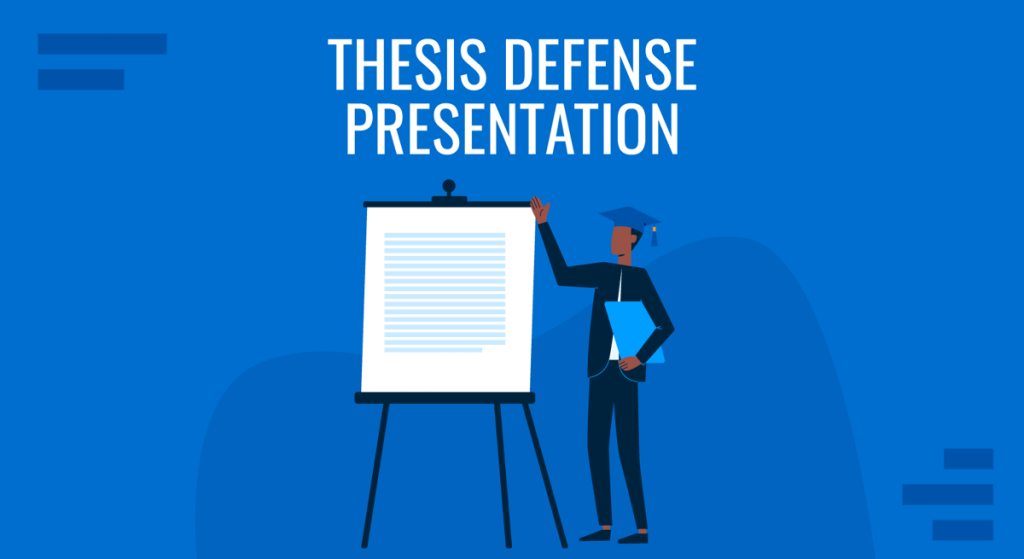
Writing a thesis is stressful, but preparing an oral defense can be even more painful. But it doesn’t have to be; with proper preparation and a good presentation, you will be able to better equip yourself comes time to present your thesis defense.
But what makes a good thesis defense?
A proper presentation helps you with your thesis defense because it helps you capture the panels’ attention and gives you cues and reminders on what to say as well.
It also helps keep your data organized while visually looking good and provides a flow structure for the rest of your presentation.
In today’s article, we will be giving you The Right PowerPoint Templates for Your Thesis Defense and a powerful outline composed of best practices and layouts specifically designed to help you defend your thesis in both written and oral presentations.
In the next segments of this article, we’ll walk you through the most feasible process on how to ace this kind of presentation.
Let’s dive into the outline of what makes a great thesis defense.
Thesis Defense Overview
Similarities.
- Type of Degree
Thesis and Dissertation Distinction Varies on Location
Three most common thesis defense myths, how to use chatgpt to structure your thesis.
- Introduction
- Literature Review
- Methodology
- Acknowledgements
- Questions and Answers
- Contact Information
- Tips During Your Oral Defense
- More Quick Tips on How to Present
A thesis defense is composed of two parts – a thesis and a defense.
The thesis, according to Grad School Hub , represents a student’s collective understanding of his or her program and major.
Universities often include a thesis in every course as one of the final requirements to earn a particular graduate or postgraduate degree.
The thesis, however, isn’t just a mere requirement.
It helps the students to grow out of their shell from their respective discipline and give them the opportunity to present all the findings of their study.
Moreover, some people think a thesis is just a long essay, but it’s not. Unlike an essay, a thesis needs to assert something.
This can be considered one of the most crucial research documents that a student makes during their academic schooling .
On the other hand, defense is the presentation of the pieces of evidence to support and prove your research.
It’s the most essential part of the thesis process.
Your presentation has to be prepared to answer questions from members of the committee and any other panel present, and it’s your job to convince them and defend your thesis with ample proof.
Prior to presenting, you have to carefully determine what appropriate evidence should be presented before the panel, depending on what thesis you have to defend.

Thesis and Dissertation Distinguished
A thesis or dissertation is usually required to complete a particular graduate degree. These two words are often used interchangeably by most students when referring to research studies.
But while being almost similar in format or structure, it’s worth noting that they have significant differences that set them apart from each other.
The very reason why thesis and dissertation are treated the same is that these two are both extensive papers. Not just merely long essays like what others are claiming.
Both of these papers are extensive. This is why students are given ample time, usually the entire last semester of the last year of study, to complete all the requirements and finally acquire their degree.
With regards to structure, both papers are very similar with few differences.
Differences Between Thesis and Dissertation
One of the significant differences between the two is to whom the paper is assigned. A thesis is usually required for those students earning a bachelor’s or master’s degree. While a dissertation is for those, who want to obtain a doctorate degree.
However, not all students taking a master’s degree are required to make a thesis. Prior to their enrollment, they have been given a choice of whether they’ll go for a non-thesis program or with a thesis.
Those who have a plan to escalate their degree to a doctorate eventually should take the path of a thesis. This is to prepare themselves for a more extensive dissertation requirement as doctorate students. Otherwise, they will be only limited to earning a master’s degree.

But above all, the most significant difference between the two papers is the purpose for which it is written.
A thesis, like what has been mentioned above, is being done by students obtaining a bachelor’s or master’s degree and has the purpose of testing their understanding of the discipline they’re engaged with.
A thesis is focused on obtaining technical expertise.
On the other hand, a dissertation is made for students to come up with an original study that other researchers haven’t already studied.
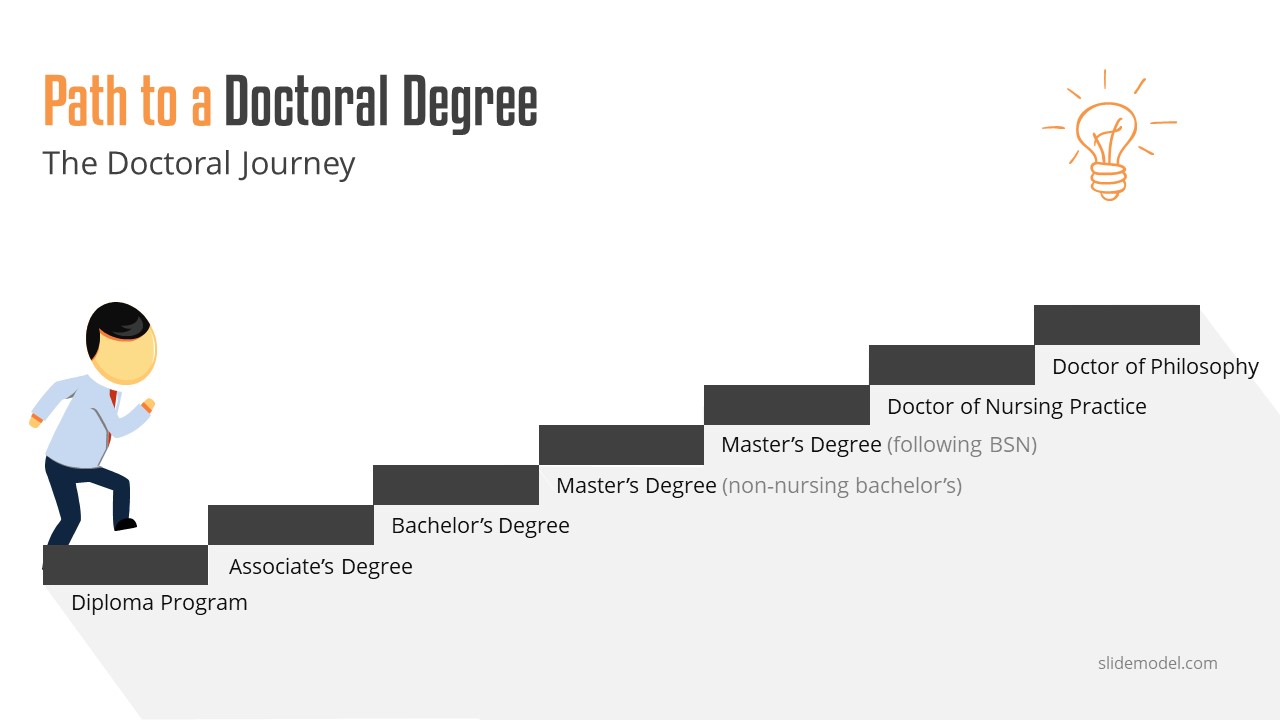
USA: In the United States of America, they consider a thesis shorter than a dissertation. In fact, aside from being a requirement to graduate in college, a thesis is now also inculcated in master’s degree programs. And since the dissertation is more extensive, the thesis is treated as preliminary in gaining a doctorate degree.
Europe: The distinction between the two papers is almost opposite to that of the USA. In Europe, a dissertation is only a broader research study from a post-graduate program and not the making of original research. Instead, educational systems in the said continent treat the doctoral thesis as a more elaborate paper writing.
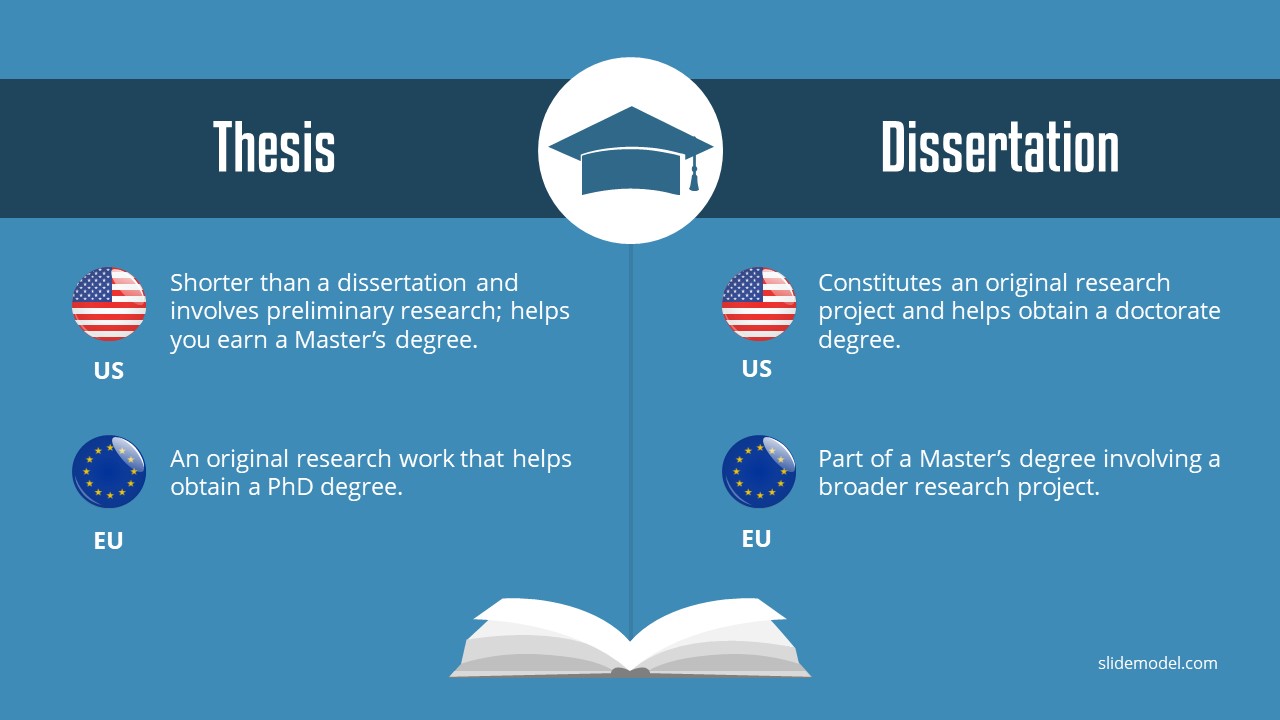
The difference between a thesis and a dissertation might not seem that big, but it’s important that we know what makes them different.
If your upcoming defense gives you pressure and uneasiness, it could be cause you are not sure what to expect. Today we will dispel three common thesis defense myths that will help you be more confident in your presentation.
“Answer all the questions correctly. Otherwise, your thesis won’t get approved.”
You are expected to have a focus on your research.
That being said, you have to study each part of your thesis, every detail, and even your sources.
You have to study and practice how to effectively deliver your presentation.
But don’t overthink to the extent that you’re stressing yourself to know everything perfectly.
Don’t overstress if you can’t answer one of the questions, this doesn’t necessarily mean the committee won’t approve your thesis.
You should know that research is a continuous study.
So you should expect that your committee will always be able to find a gap in your study to fill in future related research .
So in times you don’t exactly know the answer, admit it, and you’ll learn as they give their sides or suggestions.
Making up an answer will only displease your committee, so it’s to be upfront, honest, and transparent.
“The committee is just there to find holes in your study. They don’t care about you.”
One of the typical descriptions students have of the committee is that they are just there to poke holes in your thesis.
Going in with this perspective makes standing before them a nerve-wracking experience.
They’re not your enemy.
In fact, they are there to help you polish your study.
They might challenge you with difficult suggestions and tricky questions.
In the end, they will walk you through the process to come up with better results that won’t only benefit you but also your research.
They care about you and your study, and they’re ultimately there to make your thesis and the research better. Separate yourself from your work look at it objectively, and don’t take their comments personally .
“If your thesis defense isn’t successful, you have to start your thesis all over again”
An unsuccessful defense is one of the worst-case fears most students have.
One thing that you should be aware of is when you aren’t able to please your committee, you don’t need to start a new thesis again or go back to square one with your existing paper.
It’s unusual that your committee will ask you to change your topic and start from scratch again.
The fact that you’ve been permitted to defend your study means your research is almost complete.
They might suggest further details or ask you for minor revisions, and that’s normal.
But overall, you need to go into this defense thinking that your presentation will be successful. Otherwise, you are already setting yourself up for failure with the wrong mindset.
Remember that positive thoughts attract positive results.
Thesis Defense Presentation Structure and Slides Content
We can use language learning models like ChatGPT to help us curate the structure of our thesis presentation. Let’s see a step-by-step solution on how to apply this.
Step 1: Define the thesis topic and research questions
You can set the environment for ChatGPT to work by explaining what your thesis is going to cover and which specific questions you aim to address through the course of that document. This gives ChatGPT the context from which it shall formulate the structure. A prompt can be written like this:
“Take the role of an academic professional who shall help me to write my thesis. This thesis is going to cover the topic of (insert topic), and through its course, I want to answer these questions: Question 1 – Question 2 – Question 3 – Consider this information as the starting point for this chat.”
Step 2: Ask for an outline
With the previously provided information, ask ChatGPT to generate an outline for your presentation. If some of the points listed in the output don’t convince you, then chat with the interface until you reach a final outline. Then, ask to elaborate on each specific point for information or cues you may have overlooked.
Step 3: Ask ChatGPT which content should you place per slide
Instead of debating how are you going to trim your thesis into a presentation format, ask ChatGPT to do the decision process for you. You can be as specific as asking how many words per slide, how many slides should the presentation have, if you need any visual element, etc.
N.B.: We don’t recommend using ChatGPT to retrieve academic references as, in some cases, it can provide faulty results. You can ask if any facts on this presentation need to be checked or similar questions. ChatGPT is a powerful tool, but it shouldn’t be considered a bible, so be extra cautious about grabbing content directly from its outputs.
1. Title Page
This slide should contain the information that is provided on the title page of your hard copy . Here is an example of title page or cover slide for your title defense or thesis presentation.

- The title of your research paper
- Where you are studying
- Name and details of your course
- Name of Adviser
2. Introduction Slide
Your introduction slide should provide the committee with an idea of the following:
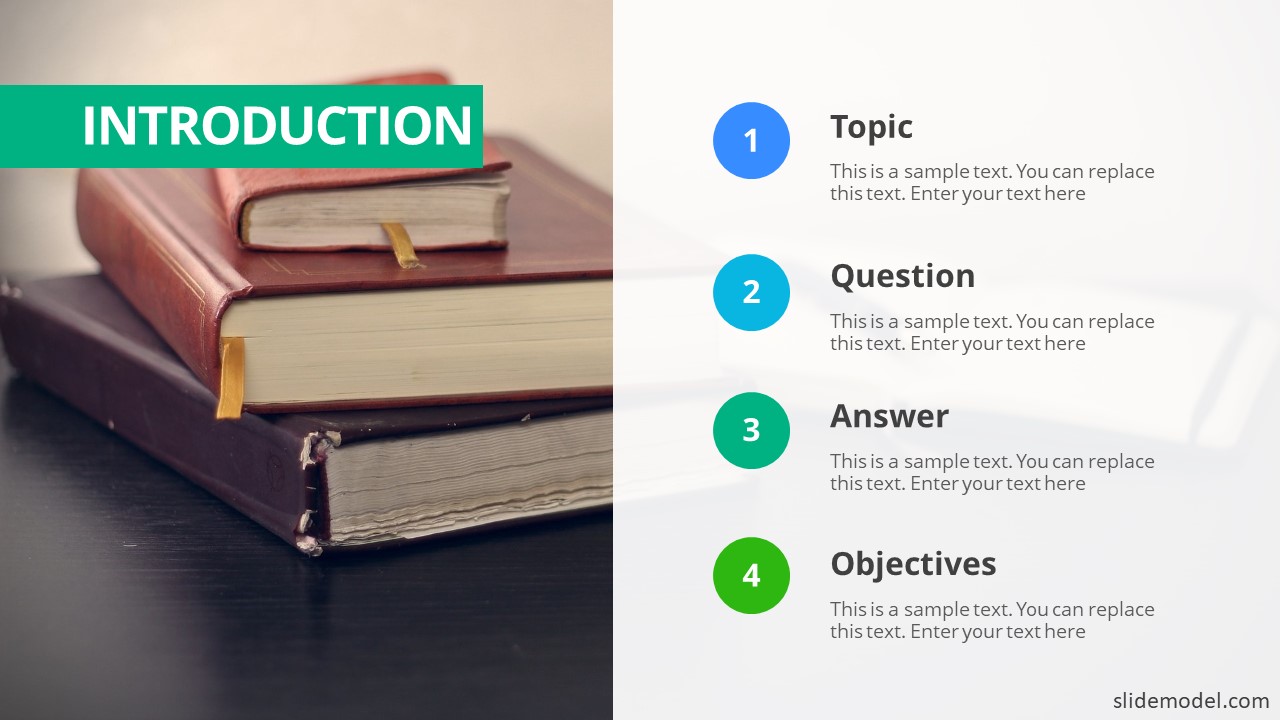
- What is the topic area that you are investigating ?
- What are the specific research questions that you set out to answer?
- Why is this question important to answer?
- What were the objectives of your research?
3. Literature Review Slide
It’s not necessary to cover everything that’s currently understood in the available literature. You may want to present the following content under a Literature Review slide:
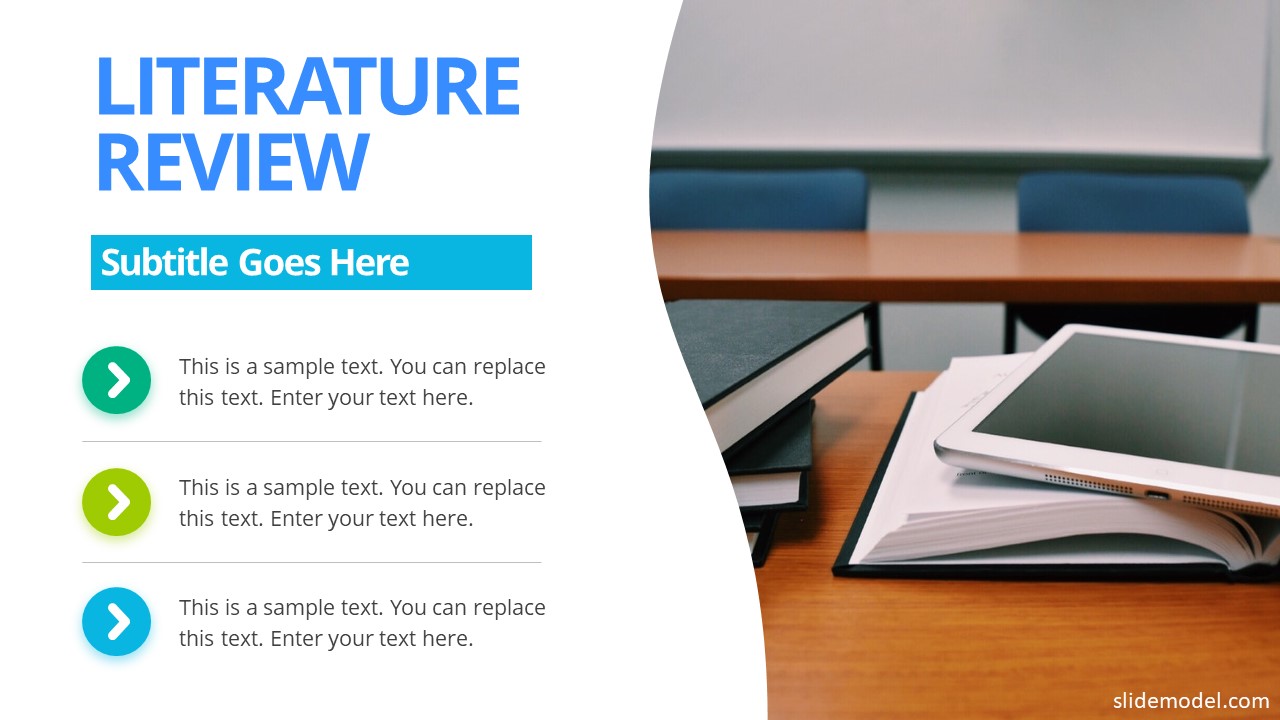
- Relevant current research that is close to your topic
- Different theories that may apply to your specific area of research
- Areas of weakness that are currently highlighted
4. Methodology Slide
Make sure to touch the factors below within your process, and include the following in the Methodology slide:

- The type of study you have conducted: qualitative, quantitative, or mixed
- The methods that you chose and why
- Details of the population, sampling methods, and other information
- Provide information regarding how you have analyzed the data that you have collected
5. Results Slide
This part should give the committee/audience a good understanding of what you’ve discovered during your research. The statistics & results slide could include the final results of your analysis, here is an example:

- An overall description of the data that you collected during your research
- The results of the analysis that you have done on that data
- What were the most significant findings from your data
6. Discussion Slide
Highlight here the meaning of the findings in relation to your discipline program and the research that you have done:
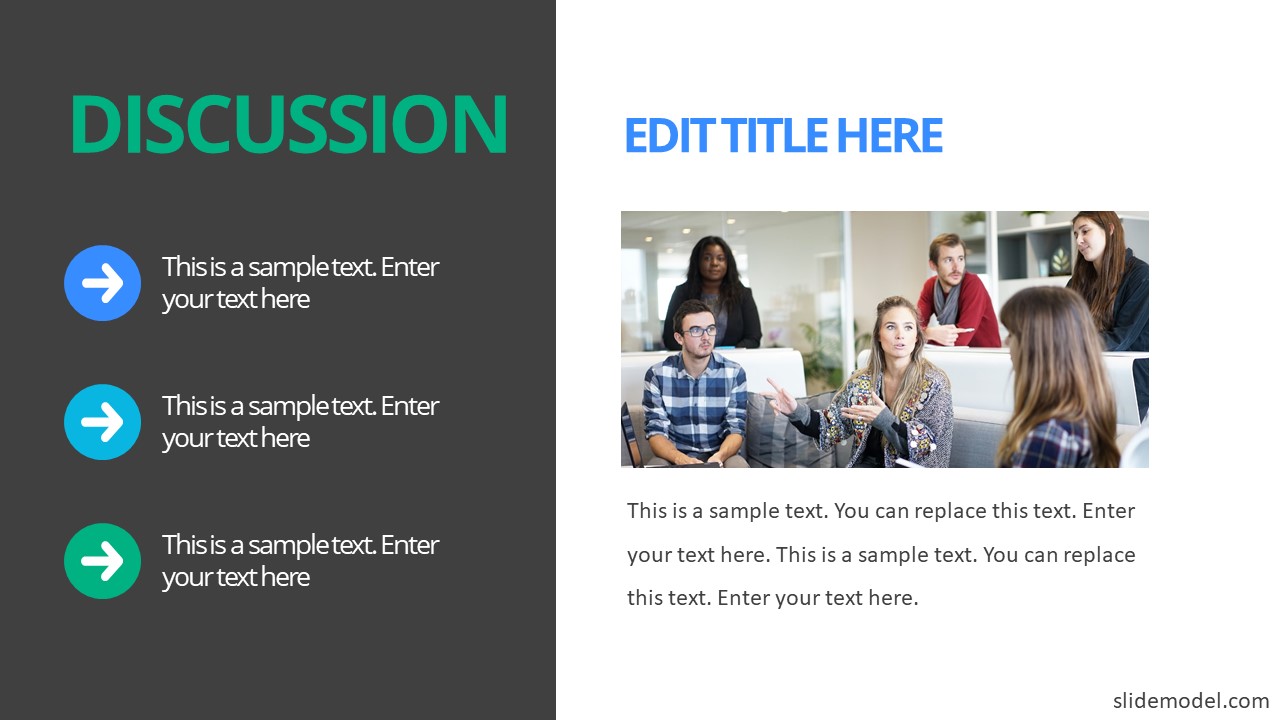
- What are the major findings, and what do they mean with regard to your research
- How do these findings relate to what others have found in the past
- How can you explain any unusual or surprising result
7. Conclusions Slide
You have to end your presentation with a conclusion summarizing all that you have found within your research. Here is an example of a Conclusion slide in a Thesis presentation:

- Restate your research questions
- Show how your results answer these questions
- Show what contribution you have made
- State any limitations to the work you have done
- Suggest future research
- Make any recommendations
See Also: How to Create a Great Investors Pitch Deck and Close the Deal
8. Acknowledgements Slide
Express gratitude to your advisor, committee members, peers, and others who supported your research journey. This slide provides a moment to acknowledge the collaborative nature of academic work.
9. Questions and Answers Slide
Dedicate a slide for audience questions at the end of your presentation.
Encourage engagement by inviting questions from the audience.
Be prepared to provide clear and concise responses to inquiries.
10. References Slide
Include a slide listing your cited sources throughout your presentation.
Use a consistent citation style (APA, MLA, Chicago, etc.).
The References slide demonstrates your thorough engagement with existing literature.
11. Contact Information Slide
If you’re open to further inquiries or collaborations, consider adding your contact information.
Include your email address or relevant professional social media handles.
How to use SlideModel AI Presentation Maker for your Thesis Presentation
If you want to save hours of manual time, you can leverage AI tools to make your thesis presentation. The best part of integrating AI tools into our workflow is that we can pair them to get even better results than we expected. With SlideModel’s AI presentation maker , users can create an entire slide deck by introducing these variables:
- Topic of your thesis
- Number of slides to include in your thesis presentation
- Outline checkup
And that’s it! Download the AI-generated presentation in PPTX format or for Google Slides, and edit it if you require adding some extra content. The core elements are already done, and you can save countless hours of hard work.
Tips During Your Oral Defense!
Review your materials.
Even if you already feel confident with your upcoming presentation, you still need to review your materials.
You can bring the hard copy of your thesis with you during the defense, but you don’t want to get lost in your presentation when you forget some specific details and have to scan your papers.
You should know your paper in and out.
Rehearse Your Presentation
It’s not wrong if it sounds like a script when you speak in your oral defense. It’s expected and understandable.
You need to practice your presentation, especially when there’s a time restriction given to every presenter.
You only need to prepare enough slides that would fit your time limit. A hundred slides aren’t suitable for a 15 to 20-minute presentation, nor 10 slides for an hour of defense.
Your rehearsal will be more effective if you practice it in front of an audience.
Note: You will experience complete silence in the defense room. You might feel awkward because, most of the time, you’re the only one speaking out loud. This is completely fine, and it’s something you should practice in rehearsal should you be afraid.
Narrow the Presentation of Ideas
Regarding your slides, you don’t have to include everything that’s in your paper. You should narrow down your ideas to the main points and the most important details, such as the statistics and findings.
If the members of your committee think you lack details or they want to hear a further explanation, they won’t hesitate to ask you.
Prepare for the Unexpected Questions
The panel tends to challenge the presenters, usually through some hard questions.
Its aim is how well do you you have done your research and how prepared you are.
But as long as you know the ins and outs of your paper, you shouldn’t lose your confidence regardless of which questions they ask.
Just keep in mind that what you’re saying in your oral defense is not in conflict with what is written on the hard copy you provided them.
What To Do When You Don’t Know the Answer
If the committee asks you a question and you don’t know the answer, don’t make up a baseless answer.
Baseless means out-of-context answers or something without proof or backup.
How To Deal With The Nervousness
The committee expects you to be nervous. Of course, it’s normal.
However, one effect of being nervous is the changes in your behavior.
There’s a tendency for you’ll talk fast, which will make it hard for the committee to understand you.
It might also cause you to have a mental block.
So try to slow down. Take a deep breath.
Inhale, exhale. Remember to breathe!
It’s OK to pause, and it’s OK to take your time; it’s more important that the committee clearly understands what you are trying to articulate.
More Quick Tips on How to Present!
- Introduce yourself at the beginning
- Introduce the title of the presentation
- Don’t read your notes if possible
- Don’t speak too fast
- Put an emphasis on what you’re saying so you don’t sound monotonous
- Look at your adviser once in a while for possible signs
- Stand on the right of the white screen if you are right-handed so you can easily refer to the slide without giving your back to the committee
- Face the audience when you talk
- Keep an eye contact
- Make sure to keep attention to the reactions of the committee and don’t forget to react in turn
We hope you enjoyed this article on how to do a proper thesis defense and how to best prepare for one using proven tips and techniques to help you get through this. Hopefully, after your defense, you will be set as the one in your class to deliver an inspiring graduation speech for your peers. If you have value, please remember to share this article. We also recommend you read these Thesis Statement Examples for inspiration to create your own professionally.
1. MasterDoc PowerPoint Template

Creating a Thesis presentation should be a straight forward task; based on your thesis document and following the tips described above you have a high level structure already outlined. The MasterDoc PowerPoint template provides professional layouts with texts and image placeholders; so you can create document like slides using your thesis defense as your content. This template is ideal for a highly detailed documents, where visuals and words unite to illustrate one concept per page. The result is an asset that can be read and digested more quickly than either your thesis document or a presentation created for assisting a speech. A document created with the MasterDoc PowerPoint templates is meant to be printed or distributed, read on screen without the accompaniment of a presenter or used in an e-learning platform as pure learning content.
Use This Template
2. Thesis Presentation PowerPoint Template
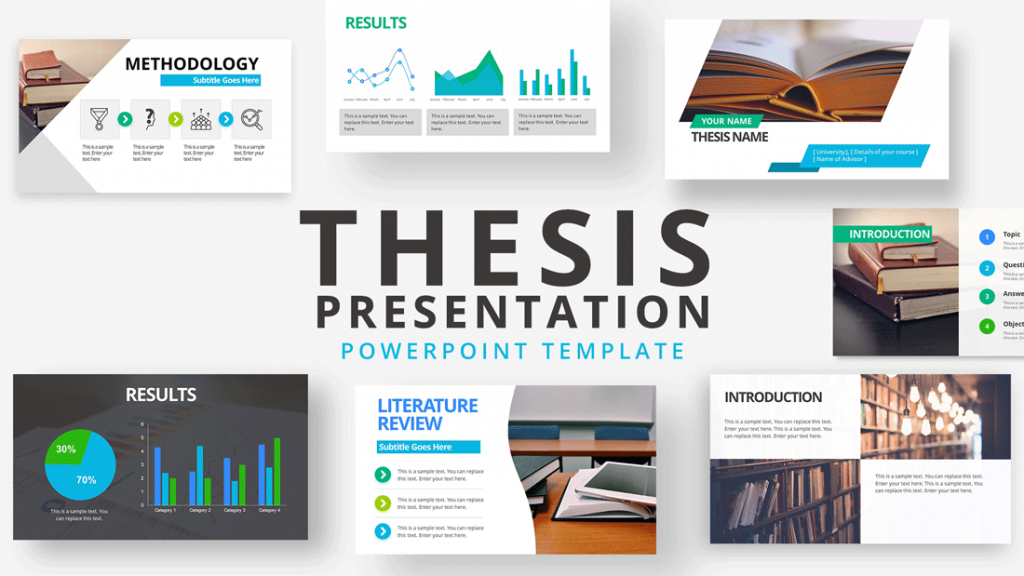
You had invested a considerable time researching, testing hypothesis and confirming your thesis. Craft your thesis presentation with the same level of detail you applied in your work. Using the Thesis Presentation PowerPoint Template you will focus only in your content and your message. The layouts, images,design and structure will be taken care by the template.
3. Master Thesis PowerPoint Template

The Master Thesis PowerPoint Template is a professional document designed for postgraduate degrees presentations. It provides simple sections that follow the structure and best practices of traditional research thesis presentations. Starting with the introduction to the theory and state of the art scenario; following with hypothesis research and its findings and concluding with the confirmation or negation of the initial thesis statement.
4. Essay Outline PowerPoint Template

Your thesis defense can be accompanied by an essay, that states your thesis and argues about it using several supporting paragraphs. This kind of document is ideal to be an intermediate step between reading assisting to the thesis presentation and reading the complete thesis documentation. It has more information that your thesis defense abstract, but does summarizes the supporting evidence and examples that allows the argument of each idea behind the thesis. You can use the Essay Outline Template to present your Essay outline and create an essay linked to your thesis defense documentation.
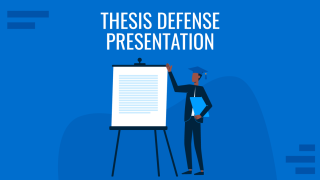
Like this article? Please share
Academics, Degree, Dissertation, Doctorate, Education, Faculty, Master, PhD, Student, Thesis Filed under Presentation Ideas
Related Articles

Filed under Presentation Ideas • November 9th, 2023
How to Create and Deliver a Research Presentation
Presentation is one of the final steps of a research endeavor. Learn how to make and deliver a research presentation using our templates and tips.

Filed under Education • September 10th, 2023
How To Write An Essay? – Where to start?
Do you wonder How to write an essay ? Start with the essay structure. This post describes the standard essay structure with its content, and which essay types are popular. Develop your writing skills using the best practices of Essay Structure.
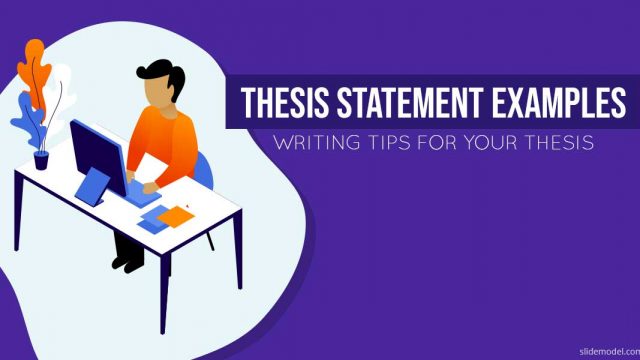
Filed under Education • September 2nd, 2023
Thesis Statement Examples
What makes a good thesis statement? Simple answer, precision and enough evidence to support your statement. In this article we analyze what are good thesis statements with examples.
36 Responses to “How To Do a Proper Thesis Defense Using the Right PowerPoint Presentation”
Great job! This has made my thesis presentation a whole lot easier.
Excellent !!!!!
Now I feel I’m quite confident on how to do my dissertation presentation properly and how to defend it. I will share that with other friends and colleagues.
Thank you so much for your kind help.
Best regards, Awad
Thank you for such a valuable guide.
it was very helpful
Thanks a bunch for the general summary for thesis defense with all related information that we might have to know. Great job!
Great tips.
i have proposal defense in two days and im so nervous right now! reading this is helpful in some ways thankyou!
It’s very helpful and understandable. Easy steps to follow.
I found it very helpful to refresh and make my self ready for my defense!
Thank you a lot this article. It’s really helpful!
Naveen Kumar S: Thank you its very Helpful. I appreciate all your effort this is very useful.
Very important and interesting so go on thank you
I really like it. In the near future I am going to present for the MA thesis. Therefore, it will guide me a lot. If you can please attach with this email the detail.
I do like the article as it proves to be valuable and worthy. I enjoyed reading every single note. It helped me feel at ease and have confidence when my viva day takes place. THANK YOU SO MUCH.
Appreciate your Assistance
Thanks a lot for the gist
Thank you so much, I got full information and knowledge.
This has made me look forward to my thesis defense. Thanks a lot
Very useful
thank you very much for your best information
Thank you very much the article is full of knowledge on Thesis as well as dissertation defense. Big Up!
I am appreciative. Well informative and educative.
Thanks immensely for these wonderful tips on presentation during defense. I personally found more useful to me as I prepare to defend my Master Dissertation.
Thank you very much! I now feel more confident.
Thanks for your good self overall usability of the Participations motivated points and contribute significantly in thesis defense practices. Best wishes to one and All
Happy To Help.
Thank you very much. As I am pursuing for my PhD in Leadership, I got it so meaningful and worth having.
Your tips on What a Thesis and Dissertation are, are on point. I have fully understood their differences and similarities. I have also noted the killer way of summaring a Power Point Presentation. Slidemodel.com…you are just a force to reckon with. I need more information…in case you have models you can share with me and those interested in this subject covered.
Thanks a million times for your timely guidance. Just preparing to do my PhD Thesis defense.
this was very, very helpful…Thank you!
Highly appreciate your effort to deliver what a student is looking for. I find your article really helpful and to the point. Thanks !
Regarding to my P.P, I’ve understood so many issues from this. Thankyou!
i got it as it is so important for my deffence presentation, thanky you very much
This Material was very hopeful and encourage any student who prepare any presentation relation with thesis. It also combined more encauragable and it enhance presentation!
Thought provoking content Thank you.
Great comments. very helpful
Leave a Reply
Purdue Online Writing Lab Purdue OWL® College of Liberal Arts
Thesis and Dissertation: Getting Started

Welcome to the Purdue OWL
This page is brought to you by the OWL at Purdue University. When printing this page, you must include the entire legal notice.
Copyright ©1995-2018 by The Writing Lab & The OWL at Purdue and Purdue University. All rights reserved. This material may not be published, reproduced, broadcast, rewritten, or redistributed without permission. Use of this site constitutes acceptance of our terms and conditions of fair use.
The resources in this section are designed to provide guidance for the first steps of the thesis or dissertation writing process. They offer tools to support the planning and managing of your project, including writing out your weekly schedule, outlining your goals, and organzing the various working elements of your project.
Weekly Goals Sheet (a.k.a. Life Map) [Word Doc]
This editable handout provides a place for you to fill in available time blocks on a weekly chart that will help you visualize the amount of time you have available to write. By using this chart, you will be able to work your writing goals into your schedule and put these goals into perspective with your day-to-day plans and responsibilities each week. This handout also contains a formula to help you determine the minimum number of pages you would need to write per day in order to complete your writing on time.
Setting a Production Schedule (Word Doc)
This editable handout can help you make sense of the various steps involved in the production of your thesis or dissertation and determine how long each step might take. A large part of this process involves (1) seeking out the most accurate and up-to-date information regarding specific document formatting requirements, (2) understanding research protocol limitations, (3) making note of deadlines, and (4) understanding your personal writing habits.
Creating a Roadmap (PDF)
Part of organizing your writing involves having a clear sense of how the different working parts relate to one another. Creating a roadmap for your dissertation early on can help you determine what the final document will include and how all the pieces are connected. This resource offers guidance on several approaches to creating a roadmap, including creating lists, maps, nut-shells, visuals, and different methods for outlining. It is important to remember that you can create more than one roadmap (or more than one type of roadmap) depending on how the different approaches discussed here meet your needs.
Dissertation Structure & Layout 101: How to structure your dissertation, thesis or research project.
By: Derek Jansen (MBA) Reviewed By: David Phair (PhD) | July 2019
So, you’ve got a decent understanding of what a dissertation is , you’ve chosen your topic and hopefully you’ve received approval for your research proposal . Awesome! Now its time to start the actual dissertation or thesis writing journey.
To craft a high-quality document, the very first thing you need to understand is dissertation structure . In this post, we’ll walk you through the generic dissertation structure and layout, step by step. We’ll start with the big picture, and then zoom into each chapter to briefly discuss the core contents. If you’re just starting out on your research journey, you should start with this post, which covers the big-picture process of how to write a dissertation or thesis .

*The Caveat *
In this post, we’ll be discussing a traditional dissertation/thesis structure and layout, which is generally used for social science research across universities, whether in the US, UK, Europe or Australia. However, some universities may have small variations on this structure (extra chapters, merged chapters, slightly different ordering, etc).
So, always check with your university if they have a prescribed structure or layout that they expect you to work with. If not, it’s safe to assume the structure we’ll discuss here is suitable. And even if they do have a prescribed structure, you’ll still get value from this post as we’ll explain the core contents of each section.
Overview: S tructuring a dissertation or thesis
- Acknowledgements page
- Abstract (or executive summary)
- Table of contents , list of figures and tables
- Chapter 1: Introduction
- Chapter 2: Literature review
- Chapter 3: Methodology
- Chapter 4: Results
- Chapter 5: Discussion
- Chapter 6: Conclusion
- Reference list
As I mentioned, some universities will have slight variations on this structure. For example, they want an additional “personal reflection chapter”, or they might prefer the results and discussion chapter to be merged into one. Regardless, the overarching flow will always be the same, as this flow reflects the research process , which we discussed here – i.e.:
- The introduction chapter presents the core research question and aims .
- The literature review chapter assesses what the current research says about this question.
- The methodology, results and discussion chapters go about undertaking new research about this question.
- The conclusion chapter (attempts to) answer the core research question .
In other words, the dissertation structure and layout reflect the research process of asking a well-defined question(s), investigating, and then answering the question – see below.

To restate that – the structure and layout of a dissertation reflect the flow of the overall research process . This is essential to understand, as each chapter will make a lot more sense if you “get” this concept. If you’re not familiar with the research process, read this post before going further.
Right. Now that we’ve covered the big picture, let’s dive a little deeper into the details of each section and chapter. Oh and by the way, you can also grab our free dissertation/thesis template here to help speed things up.
The title page of your dissertation is the very first impression the marker will get of your work, so it pays to invest some time thinking about your title. But what makes for a good title? A strong title needs to be 3 things:
- Succinct (not overly lengthy or verbose)
- Specific (not vague or ambiguous)
- Representative of the research you’re undertaking (clearly linked to your research questions)
Typically, a good title includes mention of the following:
- The broader area of the research (i.e. the overarching topic)
- The specific focus of your research (i.e. your specific context)
- Indication of research design (e.g. quantitative , qualitative , or mixed methods ).
For example:
A quantitative investigation [research design] into the antecedents of organisational trust [broader area] in the UK retail forex trading market [specific context/area of focus].
Again, some universities may have specific requirements regarding the format and structure of the title, so it’s worth double-checking expectations with your institution (if there’s no mention in the brief or study material).

Acknowledgements
This page provides you with an opportunity to say thank you to those who helped you along your research journey. Generally, it’s optional (and won’t count towards your marks), but it is academic best practice to include this.
So, who do you say thanks to? Well, there’s no prescribed requirements, but it’s common to mention the following people:
- Your dissertation supervisor or committee.
- Any professors, lecturers or academics that helped you understand the topic or methodologies.
- Any tutors, mentors or advisors.
- Your family and friends, especially spouse (for adult learners studying part-time).
There’s no need for lengthy rambling. Just state who you’re thankful to and for what (e.g. thank you to my supervisor, John Doe, for his endless patience and attentiveness) – be sincere. In terms of length, you should keep this to a page or less.
Abstract or executive summary
The dissertation abstract (or executive summary for some degrees) serves to provide the first-time reader (and marker or moderator) with a big-picture view of your research project. It should give them an understanding of the key insights and findings from the research, without them needing to read the rest of the report – in other words, it should be able to stand alone .
For it to stand alone, your abstract should cover the following key points (at a minimum):
- Your research questions and aims – what key question(s) did your research aim to answer?
- Your methodology – how did you go about investigating the topic and finding answers to your research question(s)?
- Your findings – following your own research, what did do you discover?
- Your conclusions – based on your findings, what conclusions did you draw? What answers did you find to your research question(s)?
So, in much the same way the dissertation structure mimics the research process, your abstract or executive summary should reflect the research process, from the initial stage of asking the original question to the final stage of answering that question.
In practical terms, it’s a good idea to write this section up last , once all your core chapters are complete. Otherwise, you’ll end up writing and rewriting this section multiple times (just wasting time). For a step by step guide on how to write a strong executive summary, check out this post .
Need a helping hand?
Table of contents
This section is straightforward. You’ll typically present your table of contents (TOC) first, followed by the two lists – figures and tables. I recommend that you use Microsoft Word’s automatic table of contents generator to generate your TOC. If you’re not familiar with this functionality, the video below explains it simply:
If you find that your table of contents is overly lengthy, consider removing one level of depth. Oftentimes, this can be done without detracting from the usefulness of the TOC.
Right, now that the “admin” sections are out of the way, its time to move on to your core chapters. These chapters are the heart of your dissertation and are where you’ll earn the marks. The first chapter is the introduction chapter – as you would expect, this is the time to introduce your research…
It’s important to understand that even though you’ve provided an overview of your research in your abstract, your introduction needs to be written as if the reader has not read that (remember, the abstract is essentially a standalone document). So, your introduction chapter needs to start from the very beginning, and should address the following questions:
- What will you be investigating (in plain-language, big picture-level)?
- Why is that worth investigating? How is it important to academia or business? How is it sufficiently original?
- What are your research aims and research question(s)? Note that the research questions can sometimes be presented at the end of the literature review (next chapter).
- What is the scope of your study? In other words, what will and won’t you cover ?
- How will you approach your research? In other words, what methodology will you adopt?
- How will you structure your dissertation? What are the core chapters and what will you do in each of them?
These are just the bare basic requirements for your intro chapter. Some universities will want additional bells and whistles in the intro chapter, so be sure to carefully read your brief or consult your research supervisor.
If done right, your introduction chapter will set a clear direction for the rest of your dissertation. Specifically, it will make it clear to the reader (and marker) exactly what you’ll be investigating, why that’s important, and how you’ll be going about the investigation. Conversely, if your introduction chapter leaves a first-time reader wondering what exactly you’ll be researching, you’ve still got some work to do.
Now that you’ve set a clear direction with your introduction chapter, the next step is the literature review . In this section, you will analyse the existing research (typically academic journal articles and high-quality industry publications), with a view to understanding the following questions:
- What does the literature currently say about the topic you’re investigating?
- Is the literature lacking or well established? Is it divided or in disagreement?
- How does your research fit into the bigger picture?
- How does your research contribute something original?
- How does the methodology of previous studies help you develop your own?
Depending on the nature of your study, you may also present a conceptual framework towards the end of your literature review, which you will then test in your actual research.
Again, some universities will want you to focus on some of these areas more than others, some will have additional or fewer requirements, and so on. Therefore, as always, its important to review your brief and/or discuss with your supervisor, so that you know exactly what’s expected of your literature review chapter.

Now that you’ve investigated the current state of knowledge in your literature review chapter and are familiar with the existing key theories, models and frameworks, its time to design your own research. Enter the methodology chapter – the most “science-ey” of the chapters…
In this chapter, you need to address two critical questions:
- Exactly HOW will you carry out your research (i.e. what is your intended research design)?
- Exactly WHY have you chosen to do things this way (i.e. how do you justify your design)?
Remember, the dissertation part of your degree is first and foremost about developing and demonstrating research skills . Therefore, the markers want to see that you know which methods to use, can clearly articulate why you’ve chosen then, and know how to deploy them effectively.
Importantly, this chapter requires detail – don’t hold back on the specifics. State exactly what you’ll be doing, with who, when, for how long, etc. Moreover, for every design choice you make, make sure you justify it.
In practice, you will likely end up coming back to this chapter once you’ve undertaken all your data collection and analysis, and revise it based on changes you made during the analysis phase. This is perfectly fine. Its natural for you to add an additional analysis technique, scrap an old one, etc based on where your data lead you. Of course, I’m talking about small changes here – not a fundamental switch from qualitative to quantitative, which will likely send your supervisor in a spin!
You’ve now collected your data and undertaken your analysis, whether qualitative, quantitative or mixed methods. In this chapter, you’ll present the raw results of your analysis . For example, in the case of a quant study, you’ll present the demographic data, descriptive statistics, inferential statistics , etc.
Typically, Chapter 4 is simply a presentation and description of the data, not a discussion of the meaning of the data. In other words, it’s descriptive, rather than analytical – the meaning is discussed in Chapter 5. However, some universities will want you to combine chapters 4 and 5, so that you both present and interpret the meaning of the data at the same time. Check with your institution what their preference is.
Now that you’ve presented the data analysis results, its time to interpret and analyse them. In other words, its time to discuss what they mean, especially in relation to your research question(s).
What you discuss here will depend largely on your chosen methodology. For example, if you’ve gone the quantitative route, you might discuss the relationships between variables . If you’ve gone the qualitative route, you might discuss key themes and the meanings thereof. It all depends on what your research design choices were.
Most importantly, you need to discuss your results in relation to your research questions and aims, as well as the existing literature. What do the results tell you about your research questions? Are they aligned with the existing research or at odds? If so, why might this be? Dig deep into your findings and explain what the findings suggest, in plain English.
The final chapter – you’ve made it! Now that you’ve discussed your interpretation of the results, its time to bring it back to the beginning with the conclusion chapter . In other words, its time to (attempt to) answer your original research question s (from way back in chapter 1). Clearly state what your conclusions are in terms of your research questions. This might feel a bit repetitive, as you would have touched on this in the previous chapter, but its important to bring the discussion full circle and explicitly state your answer(s) to the research question(s).

Next, you’ll typically discuss the implications of your findings? In other words, you’ve answered your research questions – but what does this mean for the real world (or even for academia)? What should now be done differently, given the new insight you’ve generated?
Lastly, you should discuss the limitations of your research, as well as what this means for future research in the area. No study is perfect, especially not a Masters-level. Discuss the shortcomings of your research. Perhaps your methodology was limited, perhaps your sample size was small or not representative, etc, etc. Don’t be afraid to critique your work – the markers want to see that you can identify the limitations of your work. This is a strength, not a weakness. Be brutal!
This marks the end of your core chapters – woohoo! From here on out, it’s pretty smooth sailing.
The reference list is straightforward. It should contain a list of all resources cited in your dissertation, in the required format, e.g. APA , Harvard, etc.
It’s essential that you use reference management software for your dissertation. Do NOT try handle your referencing manually – its far too error prone. On a reference list of multiple pages, you’re going to make mistake. To this end, I suggest considering either Mendeley or Zotero. Both are free and provide a very straightforward interface to ensure that your referencing is 100% on point. I’ve included a simple how-to video for the Mendeley software (my personal favourite) below:
Some universities may ask you to include a bibliography, as opposed to a reference list. These two things are not the same . A bibliography is similar to a reference list, except that it also includes resources which informed your thinking but were not directly cited in your dissertation. So, double-check your brief and make sure you use the right one.
The very last piece of the puzzle is the appendix or set of appendices. This is where you’ll include any supporting data and evidence. Importantly, supporting is the keyword here.
Your appendices should provide additional “nice to know”, depth-adding information, which is not critical to the core analysis. Appendices should not be used as a way to cut down word count (see this post which covers how to reduce word count ). In other words, don’t place content that is critical to the core analysis here, just to save word count. You will not earn marks on any content in the appendices, so don’t try to play the system!
Time to recap…
And there you have it – the traditional dissertation structure and layout, from A-Z. To recap, the core structure for a dissertation or thesis is (typically) as follows:
- Acknowledgments page
Most importantly, the core chapters should reflect the research process (asking, investigating and answering your research question). Moreover, the research question(s) should form the golden thread throughout your dissertation structure. Everything should revolve around the research questions, and as you’ve seen, they should form both the start point (i.e. introduction chapter) and the endpoint (i.e. conclusion chapter).
I hope this post has provided you with clarity about the traditional dissertation/thesis structure and layout. If you have any questions or comments, please leave a comment below, or feel free to get in touch with us. Also, be sure to check out the rest of the Grad Coach Blog .

Psst... there’s more!
This post was based on one of our popular Research Bootcamps . If you're working on a research project, you'll definitely want to check this out ...
You Might Also Like:

36 Comments
many thanks i found it very useful
Glad to hear that, Arun. Good luck writing your dissertation.
Such clear practical logical advice. I very much needed to read this to keep me focused in stead of fretting.. Perfect now ready to start my research!
what about scientific fields like computer or engineering thesis what is the difference in the structure? thank you very much
Thanks so much this helped me a lot!
Very helpful and accessible. What I like most is how practical the advice is along with helpful tools/ links.
Thanks Ade!
Thank you so much sir.. It was really helpful..
You’re welcome!
Hi! How many words maximum should contain the abstract?
Thank you so much 😊 Find this at the right moment
You’re most welcome. Good luck with your dissertation.
best ever benefit i got on right time thank you
Many times Clarity and vision of destination of dissertation is what makes the difference between good ,average and great researchers the same way a great automobile driver is fast with clarity of address and Clear weather conditions .
I guess Great researcher = great ideas + knowledge + great and fast data collection and modeling + great writing + high clarity on all these
You have given immense clarity from start to end.
Morning. Where will I write the definitions of what I’m referring to in my report?
Thank you so much Derek, I was almost lost! Thanks a tonnnn! Have a great day!
Thanks ! so concise and valuable
This was very helpful. Clear and concise. I know exactly what to do now.
Thank you for allowing me to go through briefly. I hope to find time to continue.
Really useful to me. Thanks a thousand times
Very interesting! It will definitely set me and many more for success. highly recommended.
Thank you soo much sir, for the opportunity to express my skills
Usefull, thanks a lot. Really clear
Very nice and easy to understand. Thank you .
That was incredibly useful. Thanks Grad Coach Crew!
My stress level just dropped at least 15 points after watching this. Just starting my thesis for my grad program and I feel a lot more capable now! Thanks for such a clear and helpful video, Emma and the GradCoach team!
Do we need to mention the number of words the dissertation contains in the main document?
It depends on your university’s requirements, so it would be best to check with them 🙂
Such a helpful post to help me get started with structuring my masters dissertation, thank you!
Great video; I appreciate that helpful information
It is so necessary or avital course
This blog is very informative for my research. Thank you
Doctoral students are required to fill out the National Research Council’s Survey of Earned Doctorates
wow this is an amazing gain in my life
This is so good
How can i arrange my specific objectives in my dissertation?
Trackbacks/Pingbacks
- What Is A Literature Review (In A Dissertation Or Thesis) - Grad Coach - […] is to write the actual literature review chapter (this is usually the second chapter in a typical dissertation or…
Submit a Comment Cancel reply
Your email address will not be published. Required fields are marked *
Save my name, email, and website in this browser for the next time I comment.
- Print Friendly
- Connections and Community: Inspiration Through Music
- Through the Eyes of an Educator: The Long Game

Search form
How to make a good thesis presentation.

A strong thesis defense is crucial for any doctorate or graduate student. Although researching and writing about your thesis topic can be a Herculean effort, the work doesn't end there. The thesis presentation is a crucial part of the dissertation defense in many academic programs.

Your impressive presentation will show the depth of research in your thesis clearly and compellingly. Your presentation gives your committee an excellent visual to validate the thesis. Impress your jury with impactful PowerPoint presentations.
What is a thesis presentation?
A thesis is an accumulation of all your research on paper. A thesis presentation can be a digital summary of your research, focusing on the core knowledge in your thesis. It's short and concise. Each slide should have a purpose, as this presentation provides a detailed insight into your thesis research and conclusions.
https://thesisgeek.com/ allows you to display the narrative progression of your thesis. The process begins by asking questions, researching the topic, creating the study, and evaluating it. By using this, you will be able to create the wow-worthy presentation.
You must pass your thesis presentation to be awarded your degree.
The Structure of Your Thesis Presentation
You can use this structure to help you align your slides to help you maintain consistency in your narrative by guiding the flow of design.
* Problem Statement * Literature Review * The Purpose of the Study * Research Questions * Instruments * Data collection * Research findings * Implications * Recommendations * You can also read about it here * Acknowledgements * Questions
Are you unsure of how to create a memorable and perfect thesis presentation? SlideModel provides unique thesis presentation templates that will impress your committee.
8 Tips for a stunning thesis presentation

1. Decluttered Slides
When the thesis presentation is structured smoothly, it will have the greatest impact. Overloaded slides will confuse both you and the panel. Each slide should be focused on a single topic, and contain minimal information.
Create a title slide that will grab the audience's attention. Keep your thesis presentation simple and concise to echo your topic.
2. Compelling Templates
Remember that the committee reviewing your thesis presentation is likely to have seen countless slideshows throughout their life. How can you impress them with something different?
Using eye-catching, customized templates adds a new dimension to the information you have collected. The fact that the templates are 100% editable allows you to save time and create a beautiful presentation in minutes. Templates also have a carefully chosen and attractive color scheme that will make your job easier.
3. Design Consistency
Each slide of your thesis presentation should be visually synchronized. Consistency in design creates a pleasing aesthetic. This consistency also makes your presentation look logical and smooth. Your committee might be distracted by sudden changes in style and lose the thread of your argument.
Choose a color scheme that corresponds to your topic, and then incorporate it into a thesis template. Stick to the color scheme and avoid changing themes drastically. Remember the primary and secondary colors of your slides. Dark-colored text should be placed on a lighter background, and light-colored text on a darker one. Keep in mind accessibility issues when choosing colors and backgrounds.
4. Engaging Visuals
Humans tend to remember more when presented with visually appealing information. Include multimedia that is relevant to your topic in your thesis defense presentation. This allows your audience to quickly glance at information.
Use HD images, audio clips, and videos to enhance your thesis presentation. Focusing on visual hierarchy is a tip you should keep in mind. You should place your content on your slides in the order you would like your audience to view it. This can be achieved by either highlighting text or increasing the slide content proportionally.
5. Data Visualizations
Data visualizations are the best way to present your research and analysis. Textual numbers and conclusions are not recommended. These slides are from a past era. Visualizations are always a great way to spice up your slide topics, whether it's about blended models or data on hybrid learning.
You can create top-notch data visualisations using a variety of templates, including charts, graphs, and trend lines. The combination of comprehensive analysis and data visualizations has a double effect of uniqueness and information digestability.
6. Attractive Infographics
Infographics can be used to draw your audience in and help you defend your thesis. Instantly, they make your information look more lively and attractive. You can create vibrant infographics using a variety of presentation templates (see above).
Use infographics to show the uniqueness of your thesis topic. You can also use it to show comparisons or improvements made in previous research on your thesis topic. These infographics are able to visualize nearly every topic, from research analysis and implications.
7. Typography
You will not get very far if you fill your slides with text. It is better to write one-liners and points instead of long paragraphs. We can assure you that your committee will not be interested in large paragraphs. Your visuals and verbal content will be the focus of their attention.
Save the rest of the information for your speech. Choose functional fonts for your slides to make the text legible. Fancy fonts can give your slides a amateur appearance and confuse your audience.
8. Include Storytelling
When presented as a story, any information or thesis becomes more engaging than a simple speech. Create a story that will help you move your presentation forward. Your audience will be captivated and want more.
Storytelling, when skillfully integrated into a thesis defense, offers several benefits. Firstly, it humanizes the research. Behind every dataset and analysis lies a researcher who embarked on a quest to unravel mysteries and contribute to knowledge. By sharing the personal journey and struggles encountered during the research, a narrative is created that resonates with the audience on a human level. This connection fosters empathy, making the defense not just a presentation of facts, but a shared experience.
Moreover, storytelling facilitates comprehension. Complex theories and intricate methodologies can be difficult for non-experts to grasp. Through storytelling, these concepts can be simplified and contextualized, making them accessible to a wider audience. Analogies, anecdotes, and relatable examples become tools to bridge the gap between specialized knowledge and general understanding.

The story you tell in your thesis presentation slide must be engaging and captivating from the beginning. Bestselling author Robin Sharma believes that starting strong can be beneficial. Finishing strong is more impressive.
To achieve this, you should design your title slide and final slides in a striking way. Practice before the final and practice the narration. Create a stunning slideshow to defend your thesis. Use the tips above...you'll be glad you did!
- Log in to post comments
Popular Tags
Wandering Educators
Music for Shifting Times

Through the Eyes of an Educator: A Compendium

Exploring Michigan's Coasts: A Compendium

Generation Study Abroad Commitment Partner

I'm a White House Travel Blogger

Wandering Educators Youth Travel Blogging Mentorship Program

Travel with Awe and Wonder: A Compendium

- Accommodations
- Books & Film
- Global Citizenship
- Intercultural Education
- Marketplace
- Opportunities
- Performing Arts
- Southeast Asia
- Special Interest
- Transportation
- Travel Planning
- Travel Tips
Recent posts
Visiting the kew gardens orc..., no idea what to see in warsa..., why teachers are natural-bor..., 3 types of meaningful holida..., 6 tips for navigating family....
- Request new password

Have a language expert improve your writing
Run a free plagiarism check in 10 minutes, automatically generate references for free.
- Knowledge Base
- Dissertation
How to Write a Dissertation Proposal | A Step-by-Step Guide
Published on 14 February 2020 by Jack Caulfield . Revised on 11 November 2022.
A dissertation proposal describes the research you want to do: what it’s about, how you’ll conduct it, and why it’s worthwhile. You will probably have to write a proposal before starting your dissertation as an undergraduate or postgraduate student.
A dissertation proposal should generally include:
- An introduction to your topic and aims
- A literature review of the current state of knowledge
- An outline of your proposed methodology
- A discussion of the possible implications of the research
- A bibliography of relevant sources
Dissertation proposals vary a lot in terms of length and structure, so make sure to follow any guidelines given to you by your institution, and check with your supervisor when you’re unsure.
Instantly correct all language mistakes in your text
Be assured that you'll submit flawless writing. Upload your document to correct all your mistakes.

Table of contents
Step 1: coming up with an idea, step 2: presenting your idea in the introduction, step 3: exploring related research in the literature review, step 4: describing your methodology, step 5: outlining the potential implications of your research, step 6: creating a reference list or bibliography.
Before writing your proposal, it’s important to come up with a strong idea for your dissertation.
Find an area of your field that interests you and do some preliminary reading in that area. What are the key concerns of other researchers? What do they suggest as areas for further research, and what strikes you personally as an interesting gap in the field?
Once you have an idea, consider how to narrow it down and the best way to frame it. Don’t be too ambitious or too vague – a dissertation topic needs to be specific enough to be feasible. Move from a broad field of interest to a specific niche:
- Russian literature 19th century Russian literature The novels of Tolstoy and Dostoevsky
- Social media Mental health effects of social media Influence of social media on young adults suffering from anxiety
Prevent plagiarism, run a free check.
Like most academic texts, a dissertation proposal begins with an introduction . This is where you introduce the topic of your research, provide some background, and most importantly, present your aim , objectives and research question(s) .
Try to dive straight into your chosen topic: What’s at stake in your research? Why is it interesting? Don’t spend too long on generalisations or grand statements:
- Social media is the most important technological trend of the 21st century. It has changed the world and influences our lives every day.
- Psychologists generally agree that the ubiquity of social media in the lives of young adults today has a profound impact on their mental health. However, the exact nature of this impact needs further investigation.
Once your area of research is clear, you can present more background and context. What does the reader need to know to understand your proposed questions? What’s the current state of research on this topic, and what will your dissertation contribute to the field?
If you’re including a literature review, you don’t need to go into too much detail at this point, but give the reader a general sense of the debates that you’re intervening in.
This leads you into the most important part of the introduction: your aim, objectives and research question(s) . These should be clearly identifiable and stand out from the text – for example, you could present them using bullet points or bold font.
Make sure that your research questions are specific and workable – something you can reasonably answer within the scope of your dissertation. Avoid being too broad or having too many different questions. Remember that your goal in a dissertation proposal is to convince the reader that your research is valuable and feasible:
- Does social media harm mental health?
- What is the impact of daily social media use on 18– to 25–year–olds suffering from general anxiety disorder?
Now that your topic is clear, it’s time to explore existing research covering similar ideas. This is important because it shows you what is missing from other research in the field and ensures that you’re not asking a question someone else has already answered.
You’ve probably already done some preliminary reading, but now that your topic is more clearly defined, you need to thoroughly analyse and evaluate the most relevant sources in your literature review .
Here you should summarise the findings of other researchers and comment on gaps and problems in their studies. There may be a lot of research to cover, so make effective use of paraphrasing to write concisely:
- Smith and Prakash state that ‘our results indicate a 25% decrease in the incidence of mechanical failure after the new formula was applied’.
- Smith and Prakash’s formula reduced mechanical failures by 25%.
The point is to identify findings and theories that will influence your own research, but also to highlight gaps and limitations in previous research which your dissertation can address:
- Subsequent research has failed to replicate this result, however, suggesting a flaw in Smith and Prakash’s methods. It is likely that the failure resulted from…
Next, you’ll describe your proposed methodology : the specific things you hope to do, the structure of your research and the methods that you will use to gather and analyse data.
You should get quite specific in this section – you need to convince your supervisor that you’ve thought through your approach to the research and can realistically carry it out. This section will look quite different, and vary in length, depending on your field of study.
You may be engaged in more empirical research, focusing on data collection and discovering new information, or more theoretical research, attempting to develop a new conceptual model or add nuance to an existing one.
Dissertation research often involves both, but the content of your methodology section will vary according to how important each approach is to your dissertation.
Empirical research
Empirical research involves collecting new data and analysing it in order to answer your research questions. It can be quantitative (focused on numbers), qualitative (focused on words and meanings), or a combination of both.
With empirical research, it’s important to describe in detail how you plan to collect your data:
- Will you use surveys ? A lab experiment ? Interviews?
- What variables will you measure?
- How will you select a representative sample ?
- If other people will participate in your research, what measures will you take to ensure they are treated ethically?
- What tools (conceptual and physical) will you use, and why?
It’s appropriate to cite other research here. When you need to justify your choice of a particular research method or tool, for example, you can cite a text describing the advantages and appropriate usage of that method.
Don’t overdo this, though; you don’t need to reiterate the whole theoretical literature, just what’s relevant to the choices you have made.
Moreover, your research will necessarily involve analysing the data after you have collected it. Though you don’t know yet what the data will look like, it’s important to know what you’re looking for and indicate what methods (e.g. statistical tests , thematic analysis ) you will use.
Theoretical research
You can also do theoretical research that doesn’t involve original data collection. In this case, your methodology section will focus more on the theory you plan to work with in your dissertation: relevant conceptual models and the approach you intend to take.
For example, a literary analysis dissertation rarely involves collecting new data, but it’s still necessary to explain the theoretical approach that will be taken to the text(s) under discussion, as well as which parts of the text(s) you will focus on:
- This dissertation will utilise Foucault’s theory of panopticism to explore the theme of surveillance in Orwell’s 1984 and Kafka’s The Trial…
Here, you may refer to the same theorists you have already discussed in the literature review. In this case, the emphasis is placed on how you plan to use their contributions in your own research.
The only proofreading tool specialized in correcting academic writing
The academic proofreading tool has been trained on 1000s of academic texts and by native English editors. Making it the most accurate and reliable proofreading tool for students.

Correct my document today
You’ll usually conclude your dissertation proposal with a section discussing what you expect your research to achieve.
You obviously can’t be too sure: you don’t know yet what your results and conclusions will be. Instead, you should describe the projected implications and contribution to knowledge of your dissertation.
First, consider the potential implications of your research. Will you:
- Develop or test a theory?
- Provide new information to governments or businesses?
- Challenge a commonly held belief?
- Suggest an improvement to a specific process?
Describe the intended result of your research and the theoretical or practical impact it will have:
Finally, it’s sensible to conclude by briefly restating the contribution to knowledge you hope to make: the specific question(s) you hope to answer and the gap the answer(s) will fill in existing knowledge:
Like any academic text, it’s important that your dissertation proposal effectively references all the sources you have used. You need to include a properly formatted reference list or bibliography at the end of your proposal.
Different institutions recommend different styles of referencing – commonly used styles include Harvard , Vancouver , APA , or MHRA . If your department does not have specific requirements, choose a style and apply it consistently.
A reference list includes only the sources that you cited in your proposal. A bibliography is slightly different: it can include every source you consulted in preparing the proposal, even if you didn’t mention it in the text. In the case of a dissertation proposal, a bibliography may also list relevant sources that you haven’t yet read, but that you intend to use during the research itself.
Check with your supervisor what type of bibliography or reference list you should include.
Cite this Scribbr article
If you want to cite this source, you can copy and paste the citation or click the ‘Cite this Scribbr article’ button to automatically add the citation to our free Reference Generator.
Caulfield, J. (2022, November 11). How to Write a Dissertation Proposal | A Step-by-Step Guide. Scribbr. Retrieved 29 April 2024, from https://www.scribbr.co.uk/thesis-dissertation/proposal/
Is this article helpful?

Jack Caulfield
Other students also liked, what is a dissertation | 5 essential questions to get started, what is a literature review | guide, template, & examples, what is a research methodology | steps & tips.
Recommended pages
- Lecture timetables
- Campus maps
- Student digital services
- Staff Digital Services
- Student support
- Online registration
- Core systems
- Car parking
- Room bookings
- Staff development
Presenting your thesis
formatting your thesis.
Please refer to Regulation 7.4.2 for important information on how to format your thesis.
The Library Services guide 'Presenting your thesis' has been written as the standard for all theses presented for research degrees in the University of Birmingham.
It offers guidance on the practicalities of producing your thesis in a format that is acceptable for examination and for deposit in the library. This guide does not deal with the content and academic standard required of a thesis and on these matters you are advised to consult University Regulations, your supervisor and guidance issued by your School.
Please also see the Getting your thesis ready workshop webpage .
Thesis word limit
On submitting your thesis for examination you are required to complete a declaration form confirming the word length of your thesis. You should therefore be aware of the maximum word length for your thesis. See Regulation 7.4.2 (d).
The stated maximum number of words excludes tables, diagrams (including associated legends), appendices, list of references, footnotes and endnotes, the bibliography and any bound published material. For information on referencing styles see the iCite – referencing at the University of Birmingham webpages.
A thesis that exceeds the maximum number of words will not be accepted for examination unless permission to exceed the stated word count has been granted by the Research Progress & Awards Sub Panel. Permission to exceed the stated word count is only granted in exceptional circumstances. If you consider that you will not be able to meet the stated word limited, you are advised to discuss this with your supervisor at an early stage.
Language of your thesis
acknowledging collaborative work.
If any material is included in your thesis which is a result of collaborative working, you must include details of how much of the work is your own and how much is that of other people. See Regulation 7.4.1 (h).
It is also important to seek the prior agreement of those other people to make your thesis available in the University eTheses Repository.
Previously published or submitted work
You may include work that has already been published providing the work is properly integrated, either in the thesis or as an appendix to which reference is made - see Regulation 7.4.1 (g). It must be adequately referenced and you are advised to consult with your supervisor if you are unsure about the inclusion of any previously published work in your thesis.
For additional information please refer to the Copyright for Researchers web page
You may not include material for assessment which has already been submitted for another degree awarded at this or any other University, unless all of the conditions set out in Regulation 7.4.1 (f) are satisfied.
If you are considering including published papers in your thesis, please read the alternative format thesis guide (Word - 22KB).
Plagiarism
Plagiarism is a form of cheating and is a serious academic offence. It arises where work submitted is not the student's own and has been taken from another source. The original material is then hidden from the marker, either by not referencing it properly, by paraphrasing it or by not mentioning it at all.
For further information see the University’s Guidance on plagiarism for students .
All theses submitted for examination are checked through plagiarism detection software.
Editorial help for PGR theses
A thesis submitted for examination at the University of Birmingham must be solely the postgraduate researcher’s own work (except where University Regulations permit the inclusion of appropriately referenced collaborative research or work – see Regulation 7.4.1 . A postgraduate researcher must not employ a ‘ghost writer’ to write parts or all of the thesis, whether in draft or as a final version, on his/her behalf.
Editors, whether they are formal supervisors, informal mentors, family or friends or professional, need to be clear about the extent and nature of help they offer in the editing of University of Birmingham PGRs theses and dissertations. Supervisors of PGRs also need to be clear about the role of the third party editors as well as their own editorial role.
PGRs may use third party editorial assistance (paid or voluntary) from an outside source. This must be with the knowledge and support of supervisors and the use of third party editorial assistance must be stated in the thesis acknowledgement page.
A ‘third party’ editor cannot be used :
- To change the text of the thesis so as to clarify and/or develop the ideas and arguments;
- To reduce the length of the thesis so it falls within the specified word limit;
- To correct information within the thesis;
- To change ideas and arguments put forward within the thesis; and/or
- To translate the thesis into English.
A ‘third party’ editor can be used to offer advice on:
- Spelling and punctuation;
- Formatting and sorting of footnotes and endnotes for consistency and order;
- Ensuring the thesis follows the conventions of grammar and syntax in written English;
- Shortening long sentences and editing long paragraphs;
- Changing passives and impersonal usages into actives, vice versa as may be appropriate;
- Improving the positioning of tables and illustrations and the clarity, grammar, spelling and punctuation of any text in or under tables and illustrations; and
- Ensuring consistency of page numbers, headers and footers.
Where a third party editor is used it is the PGR’s responsibility to provide the third party editor with a copy of this statement (Word - 20KB) and ensure they complete the Third Party Editor Declaration Form (Word - 32KB) confirming their compliance with this statement.
When submitting the thesis the PGR must record in the Acknowledgements page the form of contribution the ‘third party’ editor has made, by stating for example, “this thesis was copy edited for conventions of language, spelling and grammar by ABC Editing Ltd”.
Please also see the Code of Practice on Academic Integrity .
Intellectual property rights
These rights generally belong to the student, but if your work is considered to be commercially significant students may be required to assign their rights to the University.
For further information please see:
- University Regulation 5.4 covering Intellectual Property
- Regulation 3.16 covering Patents and The Exploitation of Inventions
- The Copyright for Researchers webpage
Can't find what you're looking for?
- College of Arts and Law
- College of Engineering and Physical Sciences
- College of Life and Environmental Sciences
- College of Medical and Dental Sciences
- College of Social Sciences
Professional Services
- Academic Services
- Campus Services
- Development and Alumni Relations
- Executive Support
- External Relations
- Human Resources
- IT Services
- Legal Services
- Research Strategy and Services

IMAGES
VIDEO
COMMENTS
How to Prepare for your Dissertation Presentation. The best way to prepare for your Dissertation Presentation is to review your work carefully. Take notes of the key decisions you have made throughout your research and the scholarly literature that supports these choices. Make sure that you have a thorough understanding of the scholarly context ...
The presentation of dissertation findings is a critical component in the successful completion of a master's degree program. As the culmination of years of hard work, research, and dedication, your dissertation stands as a testament to your academic prowess and your ability to contribute meaningfully to your chosen field.
Check out the following tips to pull off your master thesis defense with a great presentation: 1. Properly structure your slide deck. Every master thesis defense presentation is unique, but most effective slide decks will follow a similar structure, including: Title - Just like a research paper, your thesis presentation must include a title ...
To present your thesis information in a clear, concise, and ultimately amazing way, you can use one of our unique thesis defense templates, available at Slidesgo. As an example, in this article, we are going to use the Ecology Thesis template. With it, we will show you what to include in your presentation and how to make an attractive design.
Keeping your defense simple will cut through all the other noise. Work on narrowing the focus of each slide to cover one point. Just one. Condensing ideas is tough, especially when you're discussing a complex issue. But taking your presentation one slide at a time ensures the audience can follow your argument clearly.
The Dissertation Office also receives academic progress inquiries and applications for the Master of Philosophy (M.Phil.) degree. The Dissertation Office is located in 107 Low Memorial Library and is open Monday through Friday from 9:00 a.m. to 5:00 p.m. Fax: (212) 854-2863, though scanned documents via email are preferred.
A dissertation presentation is usually a 10-15 minute overview of your dissertation research that focuses on the study and findings recorded in chapters four and five of your dissertation. The dissertation presentation consists of 9-12 slides made using PowerPoint or another type of presentation software. There are conventions to adhere to when ...
Here are some tips I learned that may help you with your next research presentation: More is more. In general, your presentation will always benefit from more practice, more feedback, and more revision. By practicing in front of friends, you can get comfortable with presenting your work while receiving feedback. It is hard to know how to revise ...
The oral defense of your dissertation is, in essence, your formal introduction to your new colleagues—you are the expert on your subject. In the defense you'll be expected to cogently and clearly explain your work and how it fits with other research and scholarship in your field. The exact nature of the oral defense varies by discipline and ...
Your dissertation defense presentation is your masterpiece. It can sway the committee members in your favor. Designing a good dissertation ppt presentation that implores the audience to say that much-wanted YES is an art. Once you get the basics right, you will start off with a bang. The basic setup which you should employ while putting ...
Craft a convincing dissertation or thesis research proposal. Write a clear, compelling introduction chapter. Undertake a thorough review of the existing research and write up a literature review. Undertake your own research. Present and interpret your findings. Draw a conclusion and discuss the implications.
The material to be included in the thesis should be arranged within the following. sections: Preliminary pages: All material necessary to prepare the reader for the main text to come by giving information relating to its physical contents and background. Main text: The main body of the thesis divided into chapters.
Here are some simple tips for creating an effective PowerPoint Presentation. Less is more: You want to give enough information to make your audience want to read your paper. So include details, but not too many, and avoid too many formulas and technical jargon. Clean and professional: Avoid excessive colors, distracting backgrounds, font ...
Myth #1. "Answer all the questions correctly. Otherwise, your thesis won't get approved.". You are expected to have a focus on your research. That being said, you have to study each part of your thesis, every detail, and even your sources. You have to study and practice how to effectively deliver your presentation.
Thesis and Dissertation: Getting Started. The resources in this section are designed to provide guidance for the first steps of the thesis or dissertation writing process. They offer tools to support the planning and managing of your project, including writing out your weekly schedule, outlining your goals, and organzing the various working ...
Time to recap…. And there you have it - the traditional dissertation structure and layout, from A-Z. To recap, the core structure for a dissertation or thesis is (typically) as follows: Title page. Acknowledgments page. Abstract (or executive summary) Table of contents, list of figures and tables.
A strong thesis defense is crucial for any doctorate or graduate student. Although researching and writing about your thesis topic can be a Herculean effort, the work doesn't end there. The thesis presentation is a crucial part of the dissertation defense in many academic programs. Your impressive presentation will show the depth of research in your thesis clearly and compellingly. Your ...
Table of contents. Step 1: Coming up with an idea. Step 2: Presenting your idea in the introduction. Step 3: Exploring related research in the literature review. Step 4: Describing your methodology. Step 5: Outlining the potential implications of your research. Step 6: Creating a reference list or bibliography.
These two principles should help: First, a conference abstract is not the same as your dissertation abstract. Second, a conference paper and a dissertation are two different genres of communication. This means that your conference abstract should at most be based on one or two of your dissertation chapters. A good 20- to 25-minute presentation ...
Presenting your dissertation. All dissertations should include the following: Title page: check what style or format for titles is appropriate for your subject area. It can be helpful to have something intriguing or snappy, but with a subtitle that makes your topic/approach clear. The title page will probably also include submission information ...
Scheduling your dissertation proposal presentation with your committee is a great accomplishment. For some, presenting this project is a scary feat. Here are some tips to help you: Do: 1. Remember you know this research! You have been working intimately with this work for months. You are truly the expert on your project!
Thesis word limit. On submitting your thesis for examination you are required to complete a declaration form confirming the word length of your thesis. You should therefore be aware of the maximum word length for your thesis. See Regulation 7.4.2 (d). The stated maximum number of words excludes tables, diagrams (including associated legends ...
39 likes, 1 comments - rbaclass2024 on April 25, 2024: "Congratulations Ebun, Elizabeth, Savannah, Andrew, Jessi, Emma L., and Ezra for presenting and defending your ...